You are using an out of date browser. It may not display this or other websites correctly.
You should upgrade or use an alternative browser.
You should upgrade or use an alternative browser.
Campfire Audio Polaris 2
- Added by B9Scrambler
- Create date
descloud
100+ Head-Fier
Pros: Sub-bass extension and impact is the best I've heard in an IEM
Ability to EQ and technicalities seem proper for the price
When EQ'd - it sounds excellent
Generally comfortable and I can wear for a couple of hours a time
Color combination of choice is a real looker
Build and feel is excellent
Accessories it came with and packaging are also excellent
Ability to EQ and technicalities seem proper for the price
When EQ'd - it sounds excellent
Generally comfortable and I can wear for a couple of hours a time
Color combination of choice is a real looker
Build and feel is excellent
Accessories it came with and packaging are also excellent
Cons: Bass bleeds into midrange and can be too much for most
Treble emphasis prevents it from sounding too dull, but that treble spike presents its own problems
Stock tonality seems to cater to a very specific category of listeners
Timbre is also not correct in stock tonality
Coating isn't durable, as evident by many owners showing their CA IEMs after a long while when they're not handled with extreme care
Treble emphasis prevents it from sounding too dull, but that treble spike presents its own problems
Stock tonality seems to cater to a very specific category of listeners
Timbre is also not correct in stock tonality
Coating isn't durable, as evident by many owners showing their CA IEMs after a long while when they're not handled with extreme care
Preface
I will admit, this is my first Campfire Audio gear. Probably not a good entry point given that all the write-ups I’ve read about these are that it’s a very specific type of tuning, mostly for the bass heads from what I’ve gathered. On top of that, there aren’t really a lot of write-ups for the Polaris V2, which seems to align with the notion that these are tuned for a specific set of listeners. Notable reviewers like Resolve and Crin don’t particularly like these.From all the models I’ve read about Campfire Audio, the Andromeda seems to be their bread and butter for the crowd given that they would go out of their way to make seemingly endless iterations and limited editions. I recently acquired the Andromeda 2019 and will make a separate write-up for it, so I will only be diving into the Polaris V2 by itself and make comparison with the Andromeda once I’ve been able to get more listening time with it - which will be its own review section.
This is my first write-up for an IEM, so bare with me as I tackle certain areas differently from how I do write-ups for headphones. For one, our preferred ear tips are much more diverse compared to headphone ear pads. Tips contribute to the tuning, similar to ear pads for headphones. That said, IEM manufacturers typically provide us with multiple sets of ear tip types, and in different sizes. Our choice of tip material and fitment in the ear canal affects the sound signature and we have the liberty of choice, whereas most headphone manufacturers provide only a single set of ear pads (although there are exceptions, but we’ll not dive into that).
With the above paragraph, my write-up will likely be more relevant to those who would use the same ear tips I do with them.

Accessories and Packaging
At this point, this is probably not very exciting as multiple reviews show Campfire Audio having a good number of accessories in a great looking package. They may not exhibit as “premium feeling” as maybe a Sony IER series, but they’re well presented with a good set of accessories. Nothing to complain about from my end.Aesthetics, build and comfort
Aesthetics at this point, is classic Campfire Audio. You’d recognize it more often than not, except if you mistake it for a KZ from afar. But hey, mimicry is the best form of flattery is what they say. Build is unsurprisingly excellent feeling, but longevity of the aesthetics is something that’s concerning for this type of coating.
I find people (myself included) aren’t very careful with IEMs, even when I had the SE846 back then, I wasn’t particularly careful with them. Maybe part of the reason was because they’re still constructed of plastic and the type of plastic used on Shure IEMs is durable that you don’t notice scratches for them most of the time (at least the ones I owned, which are the 215, 535 LTD, and 846).
Going back on topic about longevity of how Campfire Audio coats their IEMs, it’s beautiful for sure, but it also sucks that the paint chips off fairly easily. It’s evident in a lot of CA IEMs in the used market - a good number of them have nicks on the edges and chipped paint across the body. This is a point against them. Aesthetics are short lived for this type of IEM if you’re not careful.
Last note, the blue hue with black screws and nozzle used on the Polaris V2 looks sleek for me (one of the main reasons why I decided to give it a try).
Comfort on the other hand, is pretty good. I can wear them for a couple of hours before my outer canal signals to me that they are experiencing some discomfort. I don’t think I’ve ever had IEMs that I can wear for long hours as nicely as Shure IEMs (minus the SE846 - that one is huge for me). So with my average ears, I find the comfort on these excellent compared to some others I’ve had (i.e. IM02, SE846, Klipsch X7i).
Sound
Amplification is not a concern here, such that a decent source like a Macbook Pro headphone output has more than enough headroom even with EQ applied. Trying these on my JDS Element, I had to significantly lower the system volume setting to have a volume that won’t make my ear canal bleed (exaggerating, but too loud of a volume can definitely impact your hearing in the long run).
Frequency graph for reference is mainly Crinacle’s measurements found here: Campfire Polaris V2 – In-Ear Fidelity
Further, I will add that the tips I use are the wide-bore silicon tips that they come with. I find these the most comfortable for them, and also tames the bass better than the Final Audio E-series type of tip with the small nozzle hole. The E-series tips makes them too bassy for me while somewhat emphasizing the treble a little bit more. I don’t particularly like foam tips as it’s a chore to put in and it’s not a comfier fit to my ear canals than regular silicon tips. If you’re one to use foam tips with these, my write-up below may not be as reflective of what you could be hearing - word of caution.
Tonality / Overall Signature
“Bassy”, “V-shaped”, “bass cannon”, “gobs of bass”, and so on and so forth. I’ve been reading about these for a while and these are the common descriptors. After listening to it for a good amount of time, I will have to agree, these are definitely a bassy set. It bleeds into the midrange, yes. Additionally, I agree with Crinacle that there is a mid-treble emphasis that prevents this from sounding overly warm and/or dark.
There are those that would describe this tuning as V-shaped, maybe if you were using the E-series tips, I would agree. As mentioned in the paragraph on why I chose these tips instead of the E-series ones, please read the reason two paragraphs above. With the wide-bore tips, they turn from V-shaped to simply bassy with a treble sparkle. The mids and treble tonal balance doesn’t resemble the TH-X00 tuning - whereas I do consider the TH-X00 tuning as a definite V-shape.
Breaking down each region:
- Bass - definitely quite bassy. There’s a good amount of rumble that I find “enjoyable” as well as mid-bass impact that is simply head-banging. HOWEVER, the bass does not slope down early enough that it intrudes already the lower midrange, which is definitely noticeable even on Crin’s graph. For mid-bass to lower-bass quality, I think they are fantastic, especially for modern genres. Seems a lot don’t like these, and that’s fine. People vary in bass preference and usually I’m more on the side of just slightly below the harman bass shelf. Going up to the midrange area, therein lies the first flaw for me.
- Midrange - the lower midrange to midrange proper is simply overpowered by the bass. You can see it on the graph, the bass doesn’t smooth down and in fact, the downward slope from the bass to the midrange is very gradual until about 700Hz. That’s not normal, and it is clearly audible. However, it does lend to lower male vocals with great body, but natural stringed instruments suffer a bit with too much bleeding of the bass into any strum. Female vocals on the other hand, have decent weight, but sounds a bit shrill and thin sounding when raising their pitch to higher octaves. This I would assume is partly because of the lower than expected ear resonance that’s between 2kHz - 5kHz mixed with the mid-treble spike,
- Treble - the mid-treble spike along the 8kHz region is what seems to keep these IEMs from being a complete bass cannon and sounding “dark”. However, that 8kHz is reminiscent of the treble quality I find in the DT1990. Note: it’s the treble “quality”, not treble “quantity”. This means the texture of the treble presented by this spike is similar to how I heard the DT1990 - splashy with certain roughness for cymbal crashes and hi-hats vibrations. The DT1990 still has the larger “quantity”, seeing it’s about 10dB or so above what is considered “normal”. The extension seems to be somewhat shelved too, so the area above 10kHz could also be fixed.
Overall, the stock tonality is ‘average’ and not something I’d pay $500 USD. I would rather go with an Audio Technica IM02 or Massdrop Plus given that both are cheaper and have I think a better stock tonality. I would give the tonality as a ‘pass’ for its bassy presentation.
However, applying EQ here gives them a breath of fresh air that I think makes them worthy of consideration if you are one to use EQ with them.
We’ll get into that section down the review.
Detail Retrieval (Resolution) and Dynamics
I find the detail retrieval to be “good”, not “great”. The bass bleed makes deciphering the less prominent instruments harder, but they’re there. I say this category is a “pass” for me and not class leading.
Same goes for dynamics. Bass dynamics seems to be it’s only prominent feature for this category. Anything above from midrange to lower treble has no noticeable dynamics, whereas cymbal crashes and hi-hats have decent impact when called for, but again just average compared to Focal dynamics - granted it’s an over-ear and it plays differently. To add to that, I haven’t really noticed IEMs to exhibit a great dynamic range in general, and these simply stay in that space to my ears.
Head Stage and Imaging
Oh man, head stage width on these is probably the best I’ve heard in an IEM. Not even the Shure SE846 has this particular stage width. Stage presentation is pretty cohesive and I don’t notice any abnormalities in the stage presentation.The same story goes for imaging, I think these have pretty good imaging. I will note though, I’m not one in particular to notice these qualities in either headphones or IEMs. For IEMs, the Polaris V2 is among the better ones I would consider in stage width, stage presentation and imaging. I only notice these things when the staging and imaging are above average or beyond what I would normally expect.
Timbre
In stock tuning, timbre is only a “pass”. It renders stringed instruments a bit unnaturally half the time. Male vocals tend to be good overall. Female vocals on the other hand, tend to become thin and somewhat shrill when they start raising their voices. This is mostly noticeable for Asian pop/rock where the general trend of female singers is to sing the higher octaves. Once they hit the higher pitch, it tends to not sound great.EQ
Well, after playing around with EQ on these, they simply sound in a word - fantastic. I think this headphone/IEM is the closest I followed the AutoEQ points to (minus the bass, I simply enjoy the bass quality with the tips I use).The stage width is more prominent, detail retrieval is what I would definitely expect at this MSRP. I can distinguish the different instruments a bit better, dynamics have improved slightly overall, and timbre has been refined for the most part. Female vocals don’t sound as shrill anymore when reaching higher pitch, and the grain quality in the treble has been tamed by a significant margin.
This type of IEM looks to be a desktop use for me. It can’t be a portable option in the sense that I can use almost any source and it will sound the way I like it the way it is. Applying EQ makes these engaging and more correct to me, whereas its stock tuning is simply “okay”. Now that I’ve found a good EQ setting for my preference, it’s hard to go back to it’s stock tonality. But I will say, EQing makes them a really engaging and “fun” type of headphone and corrects the pitch of vocals/instruments to something more accurate.
Conclusion
Given the Polaris V2 having a bassy signature, this is not something I think most people who aren’t into bassy signatures would be looking for. I’m one in that camp. I usually prefer a signature that’s tuned somewhat neutral and works with the majority of genres. This is not one of them, in my opinion.These are specifically tuned for those who love a good bass slamming IEM. I think these would definitely be perfect for commuting if you take the bus or train a lot. The bass wouldn't be drowned out by the noise produced. Since I don’t commute anymore, this simply works in my favor of having a stationary setup that I can EQ to my taste.
If you’re one to EQ, I would give the Polaris V2 a consideration and a great recommendation for something fun to listen to. It can be a jack-of-all trades type of sound when you EQ it as such, but simply fixing some of the acoustic balance makes them excellent sounding for what they’re being sold for at MSRP.
If you’re one who likes a more balanced signature out of the box and don’t really EQ, then I would say this isn’t for you. If you’re looking for a fun sounding IEM, this maybe something worth considering. The bass texture and impact on these out of all the IEMs I’ve tried are second to none.
All in all, I agree with Crin’s description of them. The Polaris V2 has a ton of bass that bleeds to the midrange, but has a treble emphasis that balances out the bass a little bit. He’s pretty accurate on this one based on how I hear them. I would however rate the technical grade higher compared to what Crin gave these.
Overall grade comes down to the following:
- Stock tonality - 6.7 / 10
- EQ’d tonality - 8.2 / 10
- Comfort - 7.8 / 10
- Technical Abilities - 8.5 / 10
So the Polaris V2 gets a full recommendation from me IF you are any of the following:
- A basshead
- One to listen to a lot of bassy tracks on a daily basis
- One who is looking for a commuter type of IEM where the bass does not drown out with the noise
- One who prefers a dynamic driver type of bass quality and is a tinkerer of EQ
- One who is looking for a bassy set that’s not completely V-shaped
- One who loves the aesthetic of a blue metallic IEM regardless of sound quality
- One who EQ’s regardless
Given that they just passed my stock tonality mark mixed with me simply enjoying their EQ’d sound, the Polaris V2 I think deserves a 4 / 5 rating overall (arbitrary, I know). This seems contrary to what notable reviewers would grade them, but I say they’re a great option if you use EQ on them. If you simply use them as is, you might want to test them out if you can. These aren’t a portable type of listening gear, but a stationary listening one for me.
I will give a final note, some audio gear take EQ better than others. A couple of notable gears that I’ve had that even EQ didn’t improve their tonality or show their technical abilities are the Oppo PM-3 and Massdrop Plus. There’s a couple more, but that’s not the point of this write-up.
When I will be using EQ, the headphone or IEM should fit the specific use case of being a great all arounder when listening to my stationary setup. The gear should have great tonality and technical abilities when EQ’d, otherwise they’re not on my recommended list.
If I were evaluating the gear for the case of commuting or using at an office where I don’t really have my complete setup with me, I would be more stringent in rating their stock tonality. I haven’t been commuting recently, so a portable IEM or office type of gear isn’t really what I’m looking for these days - thus not how I would be reviewing gear currently. I would still LOVE to have an IEM or headphone that has excellent tonality out of the box, similar to a Hifiman HE-500, HD600 or Focal Clear, but I’m a little more flexible with gear I buy nowadays.
As such, there are headphones/IEMs that I'd recommend because their tonality is simply great - meaning it renders natural instruments and vocals at least close to how I could hear them live, or have a tonality that's nicely coloured and I think a good number of people would enjoy it. On the other hand, there are those with stock tonality that I feel is really bad, but when EQ'd sounds amazing, and I will still give them a good mark because there's hidden potential upon that surface FR. I will mention whether I'd recommend them for those who don't EQ, and for those who use EQ - plain and simple.
A good start to the Campfire Audio line up for me, I would say. I like the IO colourway as well, so I might pick them up eventually despite their also controversial write-ups.
EuphoniousMedia
New Head-Fier
Pros: Energetic bass.
Easily adaptable to EQ.
Final Audio Type-E tips.
Nice set of accessories.
Miraculous unboxing experience.
Impressive build.
Easily adaptable to EQ.
Final Audio Type-E tips.
Nice set of accessories.
Miraculous unboxing experience.
Impressive build.
Cons: Over priced.
Sibilant on many tracks.
Competition is stiff at this price point.
Narrow soundstage.
Mids are laid back.
Sibilant on many tracks.
Competition is stiff at this price point.
Narrow soundstage.
Mids are laid back.
Introduction :
Campfire Audio needs no introduction, they are very well known, well established and easily the most recommended IEMs in high fidelity portable audio. Each of their units is handmade in Portland, Oregon.
The name “Campfire” skyrocketed after the release of Andromeda and since then, they are leading in the audio industry. Campfire is proud of their build and they know how proud their owners are.They have a prime image for Andromeda and Solaris in the audiophile community for being class leading. But does the Polaris V2 stand up to the high expectations?
Disclaimer :
The review was tested at 499$ and all the judgement was made keeping the exact same price in mind. We're not responsible for any price change that might alter this review.
The item was purchased from Singapore by an acquaintance. The unit was borrowed for an honest opinion and review.
Purchasable link :
Campfire Audio
Headphone Zone (India).
Specifications :
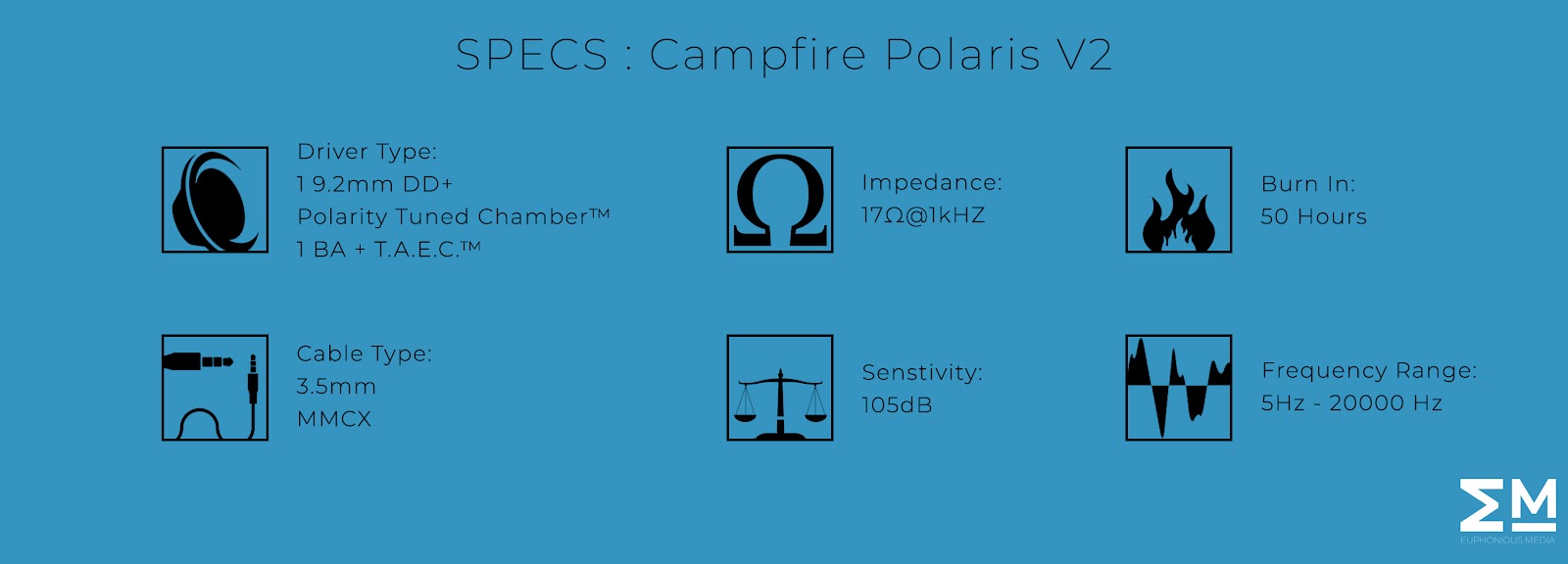
Unboxing and Accessories :
The unboxing experience is grand, Campfire never disappoints any of its users in terms of unboxing. The Campfire lineup of IEMs follow the same packaging irrespective of the price range. A beautiful box wrapped inside a sheet which opens upside down.
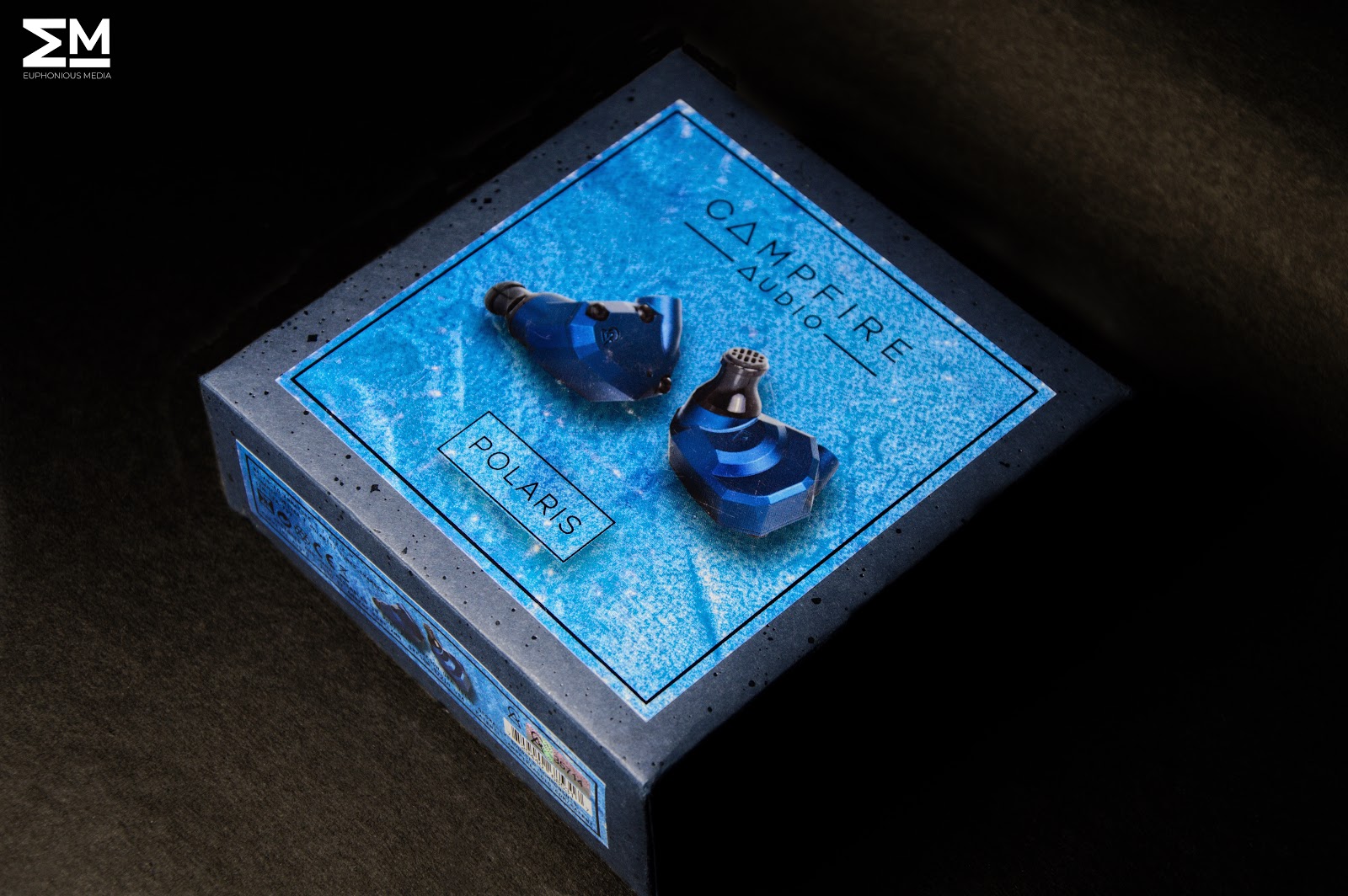
On the box, Campfire branding is present. Once you open the box, you have an extraordinary carrying case, just below the case lies another box which is filled with ample amounts of accessories. Inside the smaller box you’ll find tips ranging from Final Audio Type-E tips to silicone tips and foam tips. 3 mesh bags with Campfire branding are present which come in handy for storing IEMs, some paperwork for warranty and the Polaris which are sitting snugly inside the carrying case along with the wire. Unboxing is done very tastefully and nicely.

Cable :
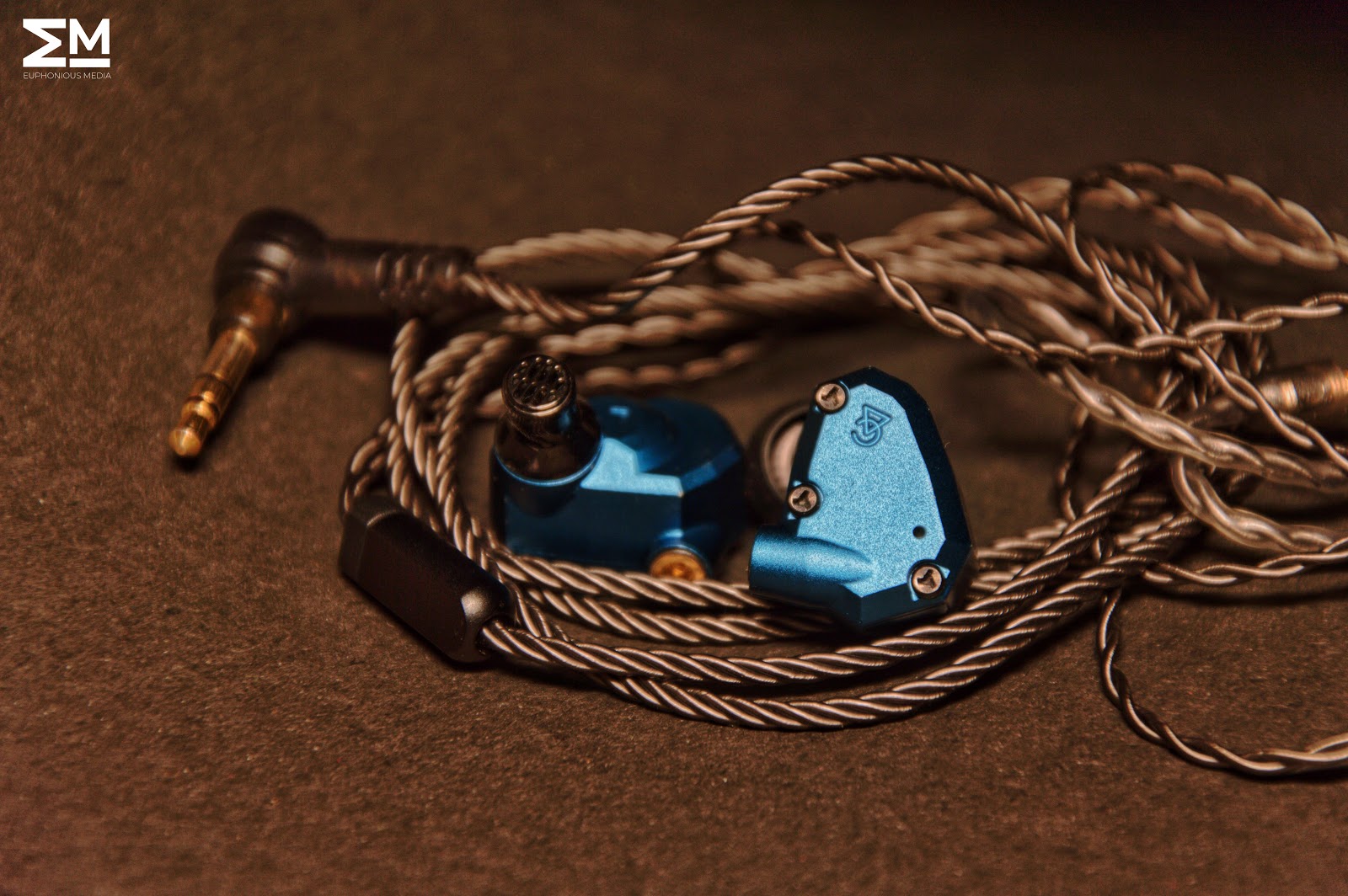
Cable that comes along with Polaris is amazing. It's a Campfire Audio smokey litz cable with beryllium plated MMCX connectors and L-type termination. It's an unbalanced cable. The Y split is made out of Aluminium and its fairly light weight. The chin slider does the job and doesn’t slide automatically. There are no cable microphonics. The provided cable quality is really good and doesn’t really need any upgrade.
Case:

The case is made out of leather, it’s shaped like a women's clutch. The chain has Campfire branding on it and on the inside, the case has wool lining. The case feels very premium and sturdy and you can feel safe carrying around your IEMs in this case.
IEM Quality and fit :

The Polaris have an icy blue color which is matte in texture. It shares the same shell as IO and Andromeda. The pair is made out of aluminium and they are quite light in weight. The finishing and material choice is excellent, every part from nozzle to PVD screws feels premium and well built. Campfire has a history of paint chipping on this particular chassis, and our unit was no different. Irresponsible and rough use will lead to paint chipping and you don’t want that to happen on a 499$ pair. Our testing was done with the famous Final Audio Type-E tips and we have to say, this is one of the best fitting IEMs. They sit in ear concha very well, extruding out quite a bit.
Sound Isolation :
It's no doubt that polaris are built well, the aluminium construction helps a lot with sound isolation. With Final Audio tips the seal we got was above expectations. They isolate sound very well and one shouldn’t be concerned about isolation on this pair at least.
The Driveability and sources used :
Polaris are quite a sensitive pair. With only 17 Ohms of impedance and 107dB of sensitivity, it gets pretty loud with almost any source. It works well with almost any smartphone and we tested it on an iPhone and the volume was pretty adequate to enjoy.
Sources used are:
Final Audio Tips :
All of the Campfire Audio lineup comes with pre included Final Audio Type-E tips (xs/s/m/l/xl). The tips are quite comfortable, enhanced the soundstage a lot and despite being universal they surprisingly fit really well. There’s no other tip that fitted this well be it Campfire marshmallow tips or silicone tips. The acoustic response and the bore width was just enough to satisfy both the comfort and sound.
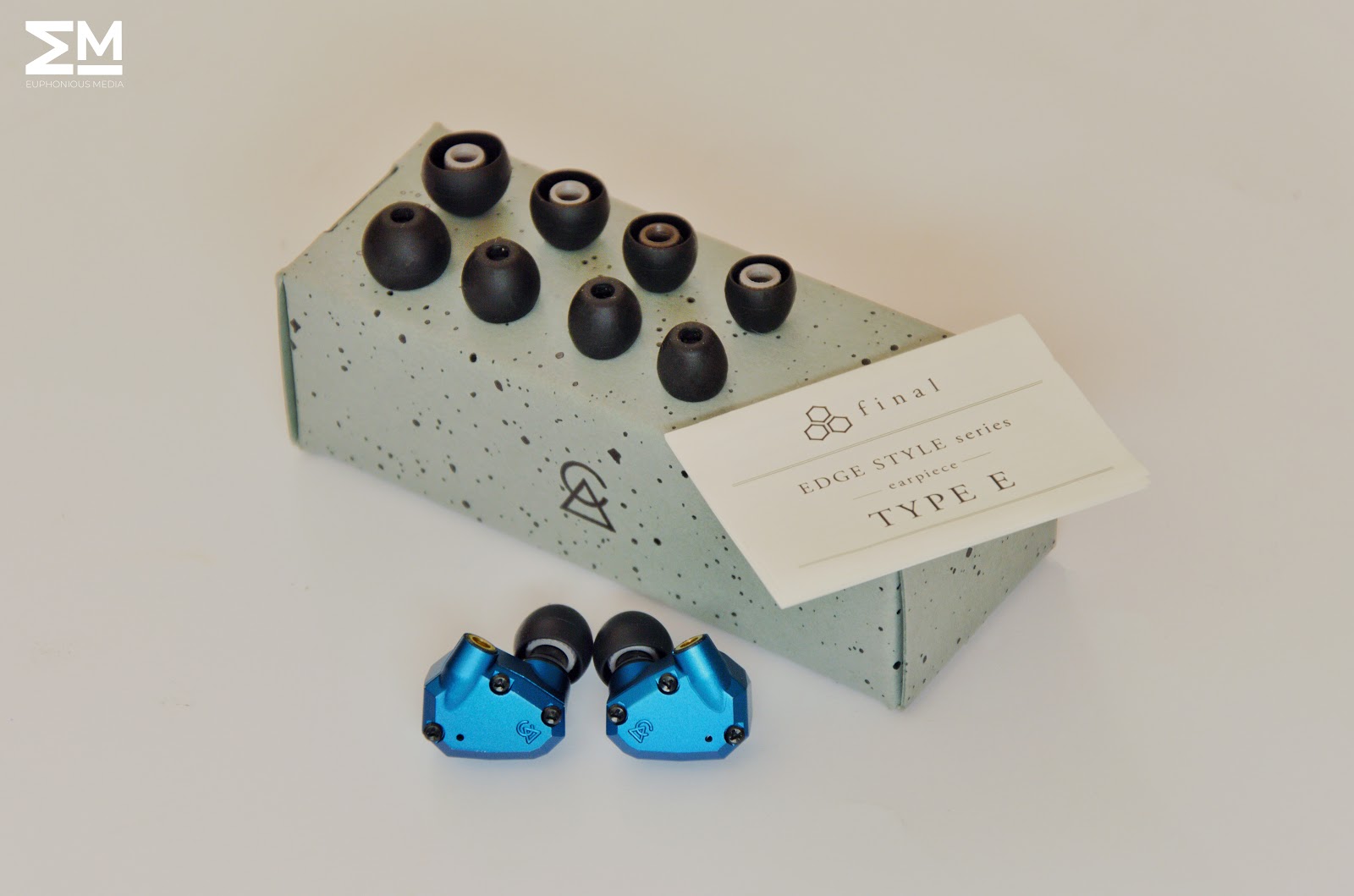
The Sound (3.5/5) :

Bass (4.5/5) :
The one thing which really over shines the other aspects of the Polaris is the BASS, the presence of which is felt with dominance and the way it is reproduced may become difficult for the rivals to match. The texture of bass is thicc and is filled with low end, on the right tracks one could actually feel like an earthquake emerging right inside of the head which could even shake the seismograph!!!, having said that due to excessive low end and rumbly nature of bass the speed of hitting notes takes a hit and due to this when one bass note ends and the second starts , the presence of first is still there which actually should not happen. Overall Polaris is the one for the bass heads undoubtedly and for those who love hip-hop and rock.
Mids (2/5) :
Owing to the fact the Polaris is amazing for the bass reproduction, but due to excessive presence of bass the mids take a serious hit. Mids are completely recessed if anyone wants to hear vocals , then the disappointment is what prevails not the vocals, though if EQ’d properly, it does improve the lacking mids but still the bass overpowers mids which is kind of a let down at this price range. Lower mids are non existing and upper mids are boosted which makes the whole signature very bright and fatiguing. Talking about detail retrieval, does an average job of reproducing the details, nothing aww worthy , no micro detail retrieval as such. As stated due to the bright signature the Male Vocals lack the oomph and sound thin and tiny, but female vocals sound decent nothing exceptional though.
Treble (3.0/5) :
According to the bright signature of the Polaris the treble is also boosted but that does not mean that it is detailed, the overall treble signature is harsh due to which the listener cannot listen to it for longer hours as the sound starts biting and those who have sensitive ears may not like the sound. As there is a peak in upper mids and treble the sound becomes sibilant though it can be adjusted by EQ as these respond very nicely with the EQ. higher mids are lacking due to which the sound lacks the details hence not as sparkly, cymbals sound realistic though.
Soundstage :
As seen with polaris, the lack of mids and higher treble result in a very narrow soundstage as the way the mids and treble is implemented the feeling of air is very less, once Eq’d properly the soundstage can improve but not drastically as we find the whole purpose of this IEM is not for analytical listening. These are a fun sounding pair for those who want to enjoy the music.
Imaging :
Imaging is very appropriate with them as Polaris is able to differentiate the use of different instruments used to reproduce the sound , but we feel due to narrow soundstage the imaging also take slight hit, but nothing negative as such. Right and Left separation is good due to which instruments do find the places in song correctly hence confirming to good imaging overall.
Reference track :
● Crash test Dummies - “ Afternoon & CoffeeSpoons “ for sound stage.
● Colter Wall - “ Thirteen Silver Dollars “ for male vocals.
● Iron Butterfly - “ In-A-Gadda-Da-Vida “ for drum solo at 6:30.
● Radio Head - “The National Anthem “ for bass guitar and separation.
● Mame Khan & Milli Nair - “Badri Badariya” for female vocals.
Conclusion :
The Polaris have 2 sides just like a coin. Either it’s loved to the core or it’s not liked much. Without wasting any further time, this is a true basshead IEM. If you are someone who needs constant rumbling bass which is humongous and energetic in sound and you’re only a fan of bass, go for it! It’s made for basshead, it’s advertised as “bassy” IEM and the Polaris serves what it says on paper. The dynamic driver on Polaris is tuned to go pretty low. They are a little subwoofer inside a metal shell ! It’s not a very musical IEM, the midrange is recessed and treble is not sparkly. Polaris adapts the EQ really well and with proper tuning you can get a lot from them. It’s a fun IEM with a hefty price tag and it’s not for everyone.
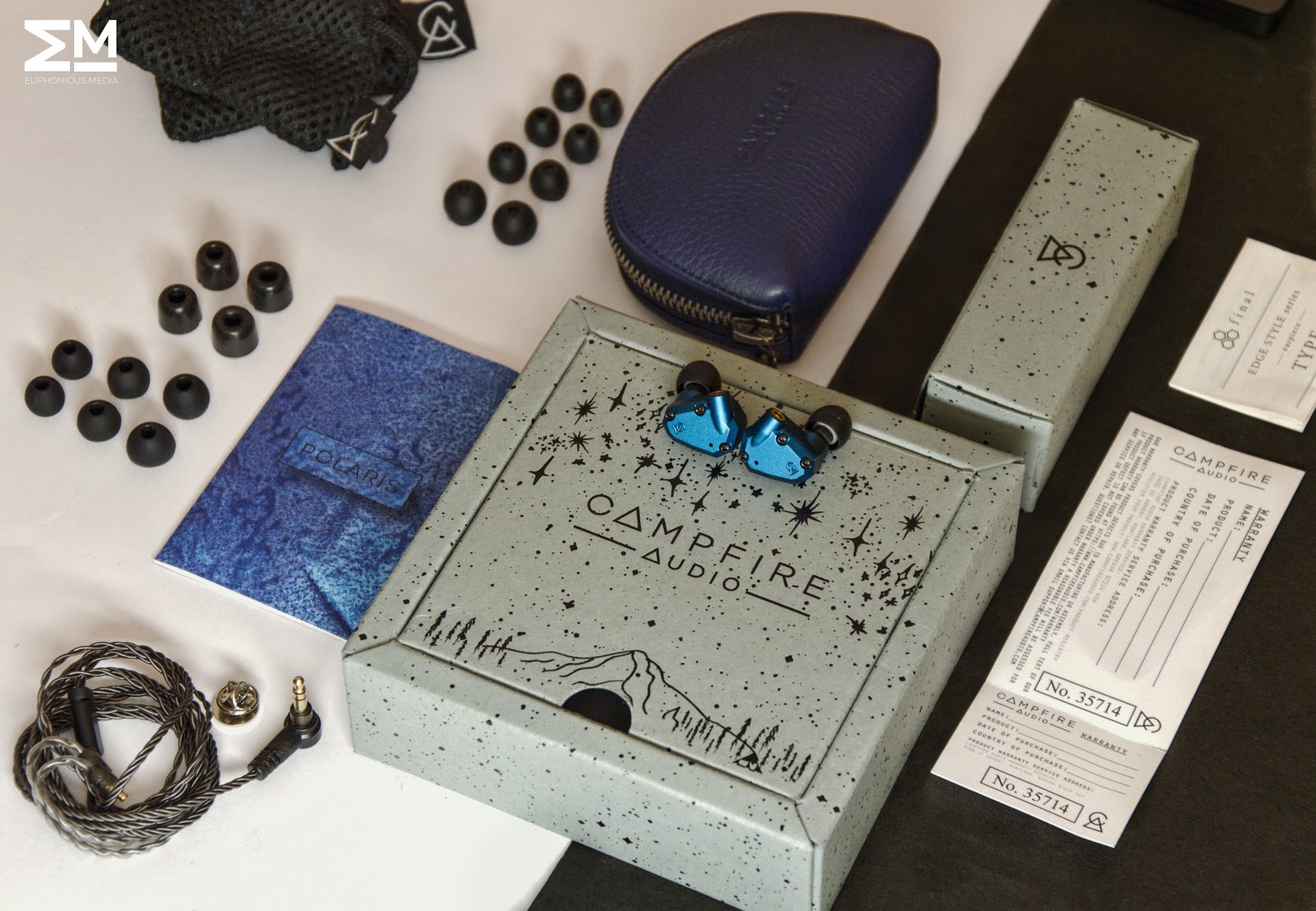

Campfire Audio needs no introduction, they are very well known, well established and easily the most recommended IEMs in high fidelity portable audio. Each of their units is handmade in Portland, Oregon.
The name “Campfire” skyrocketed after the release of Andromeda and since then, they are leading in the audio industry. Campfire is proud of their build and they know how proud their owners are.They have a prime image for Andromeda and Solaris in the audiophile community for being class leading. But does the Polaris V2 stand up to the high expectations?
Disclaimer :
The review was tested at 499$ and all the judgement was made keeping the exact same price in mind. We're not responsible for any price change that might alter this review.
The item was purchased from Singapore by an acquaintance. The unit was borrowed for an honest opinion and review.
Purchasable link :
Campfire Audio
Headphone Zone (India).
Specifications :
Unboxing and Accessories :
The unboxing experience is grand, Campfire never disappoints any of its users in terms of unboxing. The Campfire lineup of IEMs follow the same packaging irrespective of the price range. A beautiful box wrapped inside a sheet which opens upside down.
On the box, Campfire branding is present. Once you open the box, you have an extraordinary carrying case, just below the case lies another box which is filled with ample amounts of accessories. Inside the smaller box you’ll find tips ranging from Final Audio Type-E tips to silicone tips and foam tips. 3 mesh bags with Campfire branding are present which come in handy for storing IEMs, some paperwork for warranty and the Polaris which are sitting snugly inside the carrying case along with the wire. Unboxing is done very tastefully and nicely.
Cable :
Cable that comes along with Polaris is amazing. It's a Campfire Audio smokey litz cable with beryllium plated MMCX connectors and L-type termination. It's an unbalanced cable. The Y split is made out of Aluminium and its fairly light weight. The chin slider does the job and doesn’t slide automatically. There are no cable microphonics. The provided cable quality is really good and doesn’t really need any upgrade.
Case:
The case is made out of leather, it’s shaped like a women's clutch. The chain has Campfire branding on it and on the inside, the case has wool lining. The case feels very premium and sturdy and you can feel safe carrying around your IEMs in this case.
IEM Quality and fit :
The Polaris have an icy blue color which is matte in texture. It shares the same shell as IO and Andromeda. The pair is made out of aluminium and they are quite light in weight. The finishing and material choice is excellent, every part from nozzle to PVD screws feels premium and well built. Campfire has a history of paint chipping on this particular chassis, and our unit was no different. Irresponsible and rough use will lead to paint chipping and you don’t want that to happen on a 499$ pair. Our testing was done with the famous Final Audio Type-E tips and we have to say, this is one of the best fitting IEMs. They sit in ear concha very well, extruding out quite a bit.
Sound Isolation :
It's no doubt that polaris are built well, the aluminium construction helps a lot with sound isolation. With Final Audio tips the seal we got was above expectations. They isolate sound very well and one shouldn’t be concerned about isolation on this pair at least.
The Driveability and sources used :
Polaris are quite a sensitive pair. With only 17 Ohms of impedance and 107dB of sensitivity, it gets pretty loud with almost any source. It works well with almost any smartphone and we tested it on an iPhone and the volume was pretty adequate to enjoy.
Sources used are:
- iBasso DX120
- Shanling M0
- iPhone with lightning to 3.5 adapter
Final Audio Tips :
All of the Campfire Audio lineup comes with pre included Final Audio Type-E tips (xs/s/m/l/xl). The tips are quite comfortable, enhanced the soundstage a lot and despite being universal they surprisingly fit really well. There’s no other tip that fitted this well be it Campfire marshmallow tips or silicone tips. The acoustic response and the bore width was just enough to satisfy both the comfort and sound.
The Sound (3.5/5) :
Bass (4.5/5) :
The one thing which really over shines the other aspects of the Polaris is the BASS, the presence of which is felt with dominance and the way it is reproduced may become difficult for the rivals to match. The texture of bass is thicc and is filled with low end, on the right tracks one could actually feel like an earthquake emerging right inside of the head which could even shake the seismograph!!!, having said that due to excessive low end and rumbly nature of bass the speed of hitting notes takes a hit and due to this when one bass note ends and the second starts , the presence of first is still there which actually should not happen. Overall Polaris is the one for the bass heads undoubtedly and for those who love hip-hop and rock.
Mids (2/5) :
Owing to the fact the Polaris is amazing for the bass reproduction, but due to excessive presence of bass the mids take a serious hit. Mids are completely recessed if anyone wants to hear vocals , then the disappointment is what prevails not the vocals, though if EQ’d properly, it does improve the lacking mids but still the bass overpowers mids which is kind of a let down at this price range. Lower mids are non existing and upper mids are boosted which makes the whole signature very bright and fatiguing. Talking about detail retrieval, does an average job of reproducing the details, nothing aww worthy , no micro detail retrieval as such. As stated due to the bright signature the Male Vocals lack the oomph and sound thin and tiny, but female vocals sound decent nothing exceptional though.
Treble (3.0/5) :
According to the bright signature of the Polaris the treble is also boosted but that does not mean that it is detailed, the overall treble signature is harsh due to which the listener cannot listen to it for longer hours as the sound starts biting and those who have sensitive ears may not like the sound. As there is a peak in upper mids and treble the sound becomes sibilant though it can be adjusted by EQ as these respond very nicely with the EQ. higher mids are lacking due to which the sound lacks the details hence not as sparkly, cymbals sound realistic though.
Soundstage :
As seen with polaris, the lack of mids and higher treble result in a very narrow soundstage as the way the mids and treble is implemented the feeling of air is very less, once Eq’d properly the soundstage can improve but not drastically as we find the whole purpose of this IEM is not for analytical listening. These are a fun sounding pair for those who want to enjoy the music.
Imaging :
Imaging is very appropriate with them as Polaris is able to differentiate the use of different instruments used to reproduce the sound , but we feel due to narrow soundstage the imaging also take slight hit, but nothing negative as such. Right and Left separation is good due to which instruments do find the places in song correctly hence confirming to good imaging overall.
Reference track :
● Crash test Dummies - “ Afternoon & CoffeeSpoons “ for sound stage.
● Colter Wall - “ Thirteen Silver Dollars “ for male vocals.
● Iron Butterfly - “ In-A-Gadda-Da-Vida “ for drum solo at 6:30.
● Radio Head - “The National Anthem “ for bass guitar and separation.
● Mame Khan & Milli Nair - “Badri Badariya” for female vocals.
Conclusion :
The Polaris have 2 sides just like a coin. Either it’s loved to the core or it’s not liked much. Without wasting any further time, this is a true basshead IEM. If you are someone who needs constant rumbling bass which is humongous and energetic in sound and you’re only a fan of bass, go for it! It’s made for basshead, it’s advertised as “bassy” IEM and the Polaris serves what it says on paper. The dynamic driver on Polaris is tuned to go pretty low. They are a little subwoofer inside a metal shell ! It’s not a very musical IEM, the midrange is recessed and treble is not sparkly. Polaris adapts the EQ really well and with proper tuning you can get a lot from them. It’s a fun IEM with a hefty price tag and it’s not for everyone.
Ace Bee
Very nice and honest reviews. Would like to see some comparison also, track by track.
EuphoniousMedia
@Ace Bee, thank you for the feedback! We will keep in mind next time.
corgifall
1000+ Head-Fier
Pros: Nice deep bass. Beautiful iem looks. A true bass head iem.
Cons: Bass overshadows the mids, highs as well as any real detail retrieval. No amount of wide bore tips or cable rolling was able to fix this problem.

I really like a dynamic hybrid iem. When I saw the new Polaris II with a bigger dynamic driver I got stoked. I got both the IO and Polaris II at the same time but I was most excited to have a “fun” bass oriented iem. Unfortunately I was in for a frustrating week of testing. This is definitely meant for a bass head who only cares about the low end hits and that’s it. The Campfire Polaris II is using a dynamic driver and single BA setup.
Comfort and fit- The new design has a slightly longer nozzle than the older CA iems and I have no comfort issues like I do with the andros or nova of old. The Polaris II is also a light iem so it can stay in the ear longer.
Onto the review of the sound! My personal preference are a dynamic hybrid iem where I get good hitting bass and have a brighter treble with decent mids. I listen to a lot of genres but I hover in the classic rock, blues and edm music with some rap here and there.
Gear used
iPhone X with headphone adapter, FiiO m11, smsl sh8/su8 combo.
Lows- DEEP! It really digs down low and has a nice thump and rumble. The best part is that the bass is clean and never sounds bloated with wide bore tips. The DD is however slow and the rumble lingers a little too long for my tastes.
Mids- Without EQ the bass is too much. The dynamic driver isn’t fast so the mids get overshadowed by the low end. With EQ on the 250 and lower hz brought down the mids sound just ok. The vocals end up being fairly in your face which again is fine.
Highs- The treble is fairly splashy and it’s bright enough that it can fight off some of the intense low end. Once the low end gets EQ’d down it reveals a somewhat “tinny” sounding treble. Unfortunately it doesn’t do well at detail retrieval.
Imaging- It gets somewhat lost in the overpowering bass. But when EQ’d it’s correct and I have no issues with it.
Soundstage- It’s wide. Not as wide as the CA IO I bought at the same time but it runs into the issue of the bass taking over and drowning out the soundstage at times.
Cable rolling- I tried to cable roll with the intent of calming down the low end a little to obtain a more present mids and highs with no luck at all. The stock cable is nice and the connectors stay snug in the iem sockets. No noticeable floor noise going balanced which was nice.
Tip rolling- The final E tips included make the bass more intense and it actually starts to sound bloated. The foams or any wide bore tips are my recommendation to open up the sound stage and hear more of the mids and highs.
Amping- This will be fairly short. With the low end being so overpowering I couldn’t get a good sense if amping these was helping or not. The (IMO) clinical sounding FiiO m11 did actually calm the bass slightly but not in a way I could tell if more power was doing anything.
Comparisons:
Ikko oh10- the oh10 is more balanced overall sound wise and the low end isn’t as intense. It does still have a really great low end. It is however much heavier and I find the CA iems look much better in design.
ADV Sound m5-5d- These are no longer made but they still fell in the same price range as the Polaris II when they existed. The bass on the m5-5d has the same clean sound but it’s a more acceptable level of rumble and impact. The mids and highs are much more detailed than the Polaris II as well.
Overall thoughts
When I tested the Campfire IO I was a tip change away from enjoying music. It needed more bass so I was excited to pop these in and find a CA iem that wasn’t a Solaris or Atlas for a little less price wise. I thought maybe these needed a burn in since it was using a dynamic driver so I let them run from my M11’s library on repeat for 4 days straight. I spent more time frustrated and trying to calm the bass than actually listening to music. I’ll admit there were times I thought the intense bass was really fun but after a few edm tracks I was irritated by the loss of detail. These were never advertised as being anything but monster bass iems and there is indeed an audience for a thunder thumping low end and I think this works well for those seeking that type of sound signature. The biggest problem is the price. Had these been $300 like the IO I could see the focus on just the low end. These cost $500 however and unless you got money burning a hole in your pockets or you need to collect CA iems like a Pokémon trainer needs all the Pokémon, you could just get the Ikko OH10 for $189 which gets you 70ish percent of the way to the Polaris II bass rumble but with more balance and detail retrieval. For a hybrid above $300 is has to complete with my ADV M5-5D which doesn’t exist anymore so I’m always looking for a backup if it ever goes down. Unfortunately the Polaris II doesn’t come close to the sound quality of my M5-5D. I hate to rate these low since I was excited to use them and really loved the deep blue color. Once again, these never claimed to have detail as well as deep low end but I was expecting more for the price. Thanks for reading!




Last edited:
Watermelon Boi
100+ Head-Fier
Pros: Thick, bold sound with crystal clear highs
-Immersive, vibrant signature
-Great set of accessories
-Immersive, vibrant signature
-Great set of accessories
Cons: Not meant for those who seek calm/flat sound
-Some may find the sound a bit exaggerated
-Some may find the sound a bit exaggerated

Campfire Audio Polaris II Review: Tsunami
We previously covered the red, and now it's time for the blue. Campfire Audio Polaris II is an upgraded model from the original Polaris, and I remember back in the days when the first Polaris came out. I remember myself being mildly surprised as Polaris was one of their very earliest hybrid IEMs. Despite the good start, Polaris I have been discontinued shortly as Campfire moved on with their phase of products. But now it's back as Version 2, revamped from inside out. Along with us taking a look at how the Polaris II sounds and performs, I have also got myself ready with the original Polaris for the comparison. Let us now jump into the review.


Packaging
Campfire Audio finally went through some revamp with their packaging and I am happy about it. There are lots that do not pay much attention (or not at all), which is very reasonable. But I believe better packaging and boxing do matter when talking about premium IEMs. The size of the new packaging still goes for a reasonably small box but roughly twice the bigger than the old ones. Once you remove the CA sticker on the rear of the box, the outer packaging would unfold and reveal the inner box which includes all the belongings. I very much enjoy this new packaging as they are beautifully designed inside out and gives a feeling as if you are unboxing a present.
Other than the earpieces, it includes 1 set of 3.5mm stock cable, 1 leather case, 3 pairs of earpiece pouch, 5 pairs of Final Audio eartips, 3 pairs of CA eartips, 3 pairs of CA foam tips, 1 CA Lapel pin, and a cleaning tool. CA used to provide only 1 pair of earpiece pouch before, but it seems like they have realized the demand for it and started to throw in an extra 2 pairs - which I appreciate a lot. The lather case is also newly designed to have the same color as the earpiece. The size also got slightly larger for better convenience when storing with custom cables.

Earpieces
As shown, this "mechanical-looking" appearance has been Campfire Audio's signature design from the get-go. The earpiece is made of machined aluminum and sports an edgy look, though the edges are slightly rounded as well as the inner side forming a fairly ergonomic shape. Not the best in terms of comfort or compatibility, but the fit is not bothering at least. Though users with smaller outer ears will have problems fitting these to their ears as the earpieces are still a bit chunky and edgy. The color has been adjusted as well. The old Polaris used to have a dark blue shell with a black faceplate but now redesigned with a full Cerulean blue body with black screws to spice up the looks.
For the drivers, Polaris II uses a 1BA + 9.2mm 1DD hybrid setup which is each incorporated with T.A.E.C. (Tuned Acoustic Expansion Chamber) and P.T.C. (Polarity Tuned Chamber). These are specifically designed inner structures that sit in front of the driver, taking a major role in creating their signature sound. The nozzles are made of stainless steel and separated into 2 bores. Another thing to note is that the shape of the nozzle has changed. The nozzles are visibly longer than the old ones which give deeper fit and better isolation. The earpieces are detachable and use custom-made MMCX sockets that are compatible with typical ones yet inforced in durability.

Cable
The stock cable went through some changes too. The one from Polaris I had a glossy black jacket which was quite light and soft, but slightly stiff and tangly. The new version has a smoky grey jacket that solves such problems as well as being even softer. Metal memory wires are gone too and replaced with a simple ear hook design.

Sound impression - Ultra lows / Upper lows
The first thing I feel from the bass is its weight. This is not a kind of bass that aggressively smashes hard nor mushy, instead gently drops down the heavy bass. The dark, thick bass dives deep with calmness and under control. It provides a warm, meaty punch without getting out of control or making the texture mushy. While the bass is dense, the texture feels organic and doesn't show any metallic nature. These punches are bold and strong but only to the moderate level, hitting the sweet spot. Typically, basshead IEMs deliver a strong and muscular punch with large bass quantity. That sure is enjoyable, but not for too long as the strong bass slams would eventually shorten the listening session where you could use the IEM without getting your ears fatigued.
In the case of Polaris II, its deep, large, and bold bass serves my ears well to the point worth calling them a basshead IEM but also allows me to listen without getting my ears tired as the slams are not too hard or have high stiffness. It naturally and gradually stretches down towards the ultra lows with clear and manly rumble. The sub-bass continues its deep and dark characteristics and keeps the bass flow very coherent and stable - or "flat" in terms of the bass flow (not bass quantity) throughout the low range. Reverbs spread out full and naturally but keeps the atmosphere, having a delicate taste to it. Its consistently low-centered, well-condensed bass is one of the strongest charms Polaris II presents.

Sound impression - Mids / Overall presentation
One of the common characteristics from common hybrid setups is the vivid positional difference between lows and mids - lows stepping back and mids popping out to the front. That makes the sound fun along with achieving clearer mids, but it also means the imaging and presentation are getting less natural. Polaris II seeks to sit between this dilemma by having the organic dynamic driver as the base (or body) of the sound along with having a bit of glimpse of BA texture melted on the top. Not drastic, but the crunchy BA texture makes a little more exposure as it approaches the upper mids.
While mids are well distinguished, lows and mids are nicely connected with natural harmony, having more of a single driver nature. Mids are mildly forwarded or positioned similarly to the lows. The temperature is close to neutral and the brightness tips over to the darker side, just around to consider them to be dim. Vocal thickness sits around neutral or bold depending on the tone; lower mids keep the vocal meaty while the upper mids are neutral. It's a type of richness where the vocals fill the sound
CA also handled the sibilance area quite well. The sibilance area isn't "silenced" but creates a minimal amount of "s-" sound with a soft tone, just as the amount of an actual human voice would generate in real life. Not only this is fatigue-free, but it also spices up the fun and adds coolness to the atmosphere. Before and after this small peak, the vocals show a steady flow throughout the mid-range and approach to the treble.

Sound impression - Highs / etc.
If lows and mids were mostly about filling up with smoothness and depth, highs are where the crisp layerings start to kick in. Not sharp but sleek treble acts a refreshment from the deep and bassy low range. Compared to the lower range, the thickness is thinner but only slightly, keep a good balance consistency throughout the range. The crisps and sparkles are very boldly presented with snappy reaction speed. It is not a type of treble slams that pierces into the ears but enjoyable almost without any fatigues. Highs are similar or a little lesser in quantity than the mids, but the power and the brightness are always kept under control, thoroughly preventing the trebles from getting harsh or rough.
Trebles on Polaris II do a really nice job standing on a narrow apex, delivering highly vibrant and powerful textures without getting superficial or fatiguing. Despite the boosted sound, the sound is accurately presented in terms of timbre and imaging. And thanks to such nature from the trebles as well as the large bass, the staging is considerably large and very dynamic. It uplifts the sound with liveliness and intensity, making the music a lot more engaging. Polaris II sports one of the most engaging IEM among the Campfire family while keeping Campfire's house signature and maintaining a comfortable sound.

Comparing with Polaris I (Original Polaris)
My first impression of comparing these two IEMs is that Polaris II follows the exact direction the original Polaris has yet improved in all aspects in a surprisingly seamless manner. The bass is visibly darker, clearer and better condensed to the bottom, delivering a weightier punch as well as a deeper extension towards the ultra lows. Depending on tracks, the original Polaris sometimes portrayed a tonality that was somewhat "heterogeneous", DD and BA drivers being less harmonic.
On the other hand, Polaris II has not only been revised to have an organic, neutral tone but also improved in texture details too. The staging is also a major difference. The sound from Polaris II is more evenly spread out and a lot more organized, while the presentation on the original Polaris occasionally got messy or even fly over here and there without a particular focus.
Eartip / Cable suggestions
Recommended eartips for Polaris II would be either Final E-Type (the ones included as accessories) or Acoustune AET08. In this case, it would be solely up to personal preference. AET08 provides a lot more transparent, airy, and unaltered sound signature while widening the stage. E-Type, on the other hand, would deepen the bass even further and makes the thundering bass even stronger while smoothening yet not killing the mids and highs. I enjoy using these with AET08 instead, but for those who are looking to make the bass even heavier or found the trebles a little tiring, the E-types would be a more appropriate choice.
For the cable, the matching mostly works out well with pure copper or silver-plated copper ones. I would recommend Han Sound Muse II as it naturally powers up the clarity and crispiness while keeping the weighty punch from the lower ends. Pure silver or treble-oriented cables will not match for most cases. Matching such cables would easily tip over this IEM's timbre as well as overpowering the sibilance and treble.

Verdicts
Polaris II presents a very vibrant, engaging, and colorful signature that respects accuracy and neutrality. Rather than by your own will, Polaris II immerses you into its tsunami. It is very pleasing to see this IEM heading for the very same tuning the original Polaris did, which this time, CA nailed it hard. Thundering lows, shiny highs, and last but not least, its thick yet engaging mids deliver plenty of liveliness to the music. If you are seeking for a robust and fun-sounding IEM, look no more. Your answers are here!
______________________
Visit www.aboutaudio.org and follow on Instagram / Facebook for exclusive content!
______________________
Thanks to CA for providing Polaris II for an honest feedback/review.
I am not affiliated with CA and none of my words were modded or asked to be changed.
I am not affiliated with CA and none of my words were modded or asked to be changed.
ActuallySparky
"Some may find the sound a bit exaggerated" is an understatement. The Polaris are unapologetically exaggerated. It's their main selling point!
ActuallySparky
100+ Head-Fier
Pros: A fun sound signature for bass-heavy music
Comfortable fit
Excellent build quality
Reasonable stock cable
Comfortable fit
Excellent build quality
Reasonable stock cable
Cons: Not super detailed
Tuning is not ideal for all genres of music
Wind noise
Tuning is not ideal for all genres of music
Wind noise
Long time reader, first time head-fi reviewer. Hopefully this is helpful to someone out there!
I'm a basshead who generally likes fun, V-shaped sound signatures. That's not to say I can't appreciate clean, neutral sound too, but when I'm listening to electronic or rock music, I value a punchy low end that rattles my brains around.
I picked up the Polaris II as a way to step up from the chi-fi bass-heavy IEMs I'd been experimenting with recently. As fun as some of those experiments were (in particular I had a fondness for the TFZ No. 3), most of the cheaper offerings suffered bloat and poor control of the bass, presenting as tubby and smeared.
Sound
TL/DR; The Polaris are somewhat polarizing! If you like thunderous, seismic midbass, and generally listen to music with thudding basslines, you'll like the Polaris. If you don't like meaty, impactful bass then my goodness, you'll hate the Polaris.
You know those old land yachts that people put way too many subwoofers in and drive around rattling neighborhood windows? Yeah, that's what the Polaris is, but with just enough Dynamat applied to keep the car from rattling itself into oblivion. When you wear them, your head shakes just like the frame of that poor car. Polaris renders deep, slamming midbass and lots of it. Beyond having tons of volume, the lower frequencies are rendered with good texture and a warm, meaty tone. This much focus on the low end is a love it or hate it quality, and I personally love it.
Where Campfire's tuning expertise shines through is that even with all that rumbly bass, the mids and highs are still quite distinct and aren't smothered into oblivion. That being said, the low end is the star of the show. The Polaris aren't incredibly detailed in the mids, and while the T.E.A.C. BA used for the highs does add some pop and sparkle, they lack the detail and accuracy I'd normally associate with balanced armatures.
A note on tip selection - normally the first thing I do with any IEM is switch from foam to silicon tips to get the most bass out of a pair of IEMs. I did this with the Polaris, but honestly, with the Final E tips, the bass was simply too much, even for me. After a few days of burn in, I tried the foam tips, and found them the perfect way to keep the bass from overcoming everything else on these little blue IEMs.
A note on wind noise - the Polaris suffers from it. The vent on the outside likely helps with the bass performance, but leads to whistling if it's windy. Don't wear them while exercising or outside.
A few albums I listened to while writing this review:
Infected Mushroom - The Gathering: the low end performance shines on electronic music like this. There's still enough shine in the highs to pop, but every rippling bassline has punch. The Polaris rendered authoritative thump in B.P. Empire and Unbalanced, while still being reasonably smooth and musical in more organic tracks like Dance with the Kadafi.
Gorillaz - Plastic Beach: Again, the low end performance suits the Gorillaz style well. Tracks like Superfast Jellyfish demonstrate the Polaris' ability to provider decent layering, separation, and clarity to vocals over a thunderous beat. This album (and most of the Gorillaz music) is really fun with the Polaris.
Of Montreal - Skeletal Lamping: This album is hit or miss on the Polaris. Tracks with a solid and engaging bassline and come off beautifully on these IEMs, but some of the other tracks feel a little thin for the vocals buried under more bass that Of Montreal ever intended. Gronlandic Edit stood out as wonderful rendition here - the deep bassline was smooth and impactful, while the higher vocal harmony wasn't at all trampled and had great harmonics and clear rendering.
Junkie XL - Mad Max Fury Road OST: This album has a lot of intentionally hot and distorted bass. I found that particularly with the silicone tips, this sounded AWFUL on the Polaris. With the foam tips it was a little better, but with so much bass, that distortion felt amplified and overbearing. I suspect Junkie XL would be pleased to know his soundtrack was unsettling, even if some of that credit goes to to the IEM.
Carbon Based Lifeforms - Derelicts: The ambience of this album suits good low end performance well. There are some lovely droning baselines that add to the ethereal mood of the music. This is another case where the foam tips make everything sound great, but the Final E tips were simply too much and made the sound topple over from the weight of the bass.
The Mars Volta - Amputechture: This is a perfect example of where the Polaris fails to shine. A wide-ranging experimental rock experience made indistinct and boomy by the bass-heavy tuning. The lack of details in the mids takes focus away from the breathy vocals, and the bass is overbearing in a few of the more swelling moments.
Ludvig Forssell - Death Stranding OST: What a wild ride, even without the Polaris. On a few of the tracks, the low-end rumble felt to be a touch much, but overall, the juiced tuning on the Polaris handles the growling lows and isolated loneliness of this album well.
Daft Punk - Random Access Memories: Another fun album with the Polaris. Tracks throughout feature deep, smooth basslines that shake my brain. Giorgio by Moroder showcases the rendering of deep male vocals beautifully.
Build quality
The folks Campfire get high marks here. The unboxing of the Polaris was an experience, everything arranged neatly and sequentially. The IEMs themselves are thoughtfully designed for comfort, and beautifully machined. The stock cable has a plastic 3.5mm termination which isn't my favorite, but the cable itself is wonderfully pliable and tangle-free.
The included carry case is nicely implemented and feels very premium. I hope it weathers with age and becomes beautifully worn. The Polaris also comes with 2-section foam mesh dividers for keeping the two IEMs from knocking against each other in the case and scuffing their anodized finish. This is a nice touch, but it's fiddly to get them in and out and honestly I just end up shoving the IEMs and cable into the blue leather case without packing the individual monitors away separately.
Conclusion
If you like fun, engaging bass, and most of your music matches presents well with an extra subwoofer, then you'll likely enjoy the Polaris. If you don't like bass, then these will be overbearing and awful. With my musical tastes, I'll give it a 4.0. It would get a 5.0 for some genres, but it's lack of flexibility drives it down into a more specialized tool, and thus not getting top marks. One of the most fun and engaging headphones I've ever heard.
I'm a basshead who generally likes fun, V-shaped sound signatures. That's not to say I can't appreciate clean, neutral sound too, but when I'm listening to electronic or rock music, I value a punchy low end that rattles my brains around.
I picked up the Polaris II as a way to step up from the chi-fi bass-heavy IEMs I'd been experimenting with recently. As fun as some of those experiments were (in particular I had a fondness for the TFZ No. 3), most of the cheaper offerings suffered bloat and poor control of the bass, presenting as tubby and smeared.
Sound
TL/DR; The Polaris are somewhat polarizing! If you like thunderous, seismic midbass, and generally listen to music with thudding basslines, you'll like the Polaris. If you don't like meaty, impactful bass then my goodness, you'll hate the Polaris.
You know those old land yachts that people put way too many subwoofers in and drive around rattling neighborhood windows? Yeah, that's what the Polaris is, but with just enough Dynamat applied to keep the car from rattling itself into oblivion. When you wear them, your head shakes just like the frame of that poor car. Polaris renders deep, slamming midbass and lots of it. Beyond having tons of volume, the lower frequencies are rendered with good texture and a warm, meaty tone. This much focus on the low end is a love it or hate it quality, and I personally love it.
Where Campfire's tuning expertise shines through is that even with all that rumbly bass, the mids and highs are still quite distinct and aren't smothered into oblivion. That being said, the low end is the star of the show. The Polaris aren't incredibly detailed in the mids, and while the T.E.A.C. BA used for the highs does add some pop and sparkle, they lack the detail and accuracy I'd normally associate with balanced armatures.
A note on tip selection - normally the first thing I do with any IEM is switch from foam to silicon tips to get the most bass out of a pair of IEMs. I did this with the Polaris, but honestly, with the Final E tips, the bass was simply too much, even for me. After a few days of burn in, I tried the foam tips, and found them the perfect way to keep the bass from overcoming everything else on these little blue IEMs.
A note on wind noise - the Polaris suffers from it. The vent on the outside likely helps with the bass performance, but leads to whistling if it's windy. Don't wear them while exercising or outside.
A few albums I listened to while writing this review:
Infected Mushroom - The Gathering: the low end performance shines on electronic music like this. There's still enough shine in the highs to pop, but every rippling bassline has punch. The Polaris rendered authoritative thump in B.P. Empire and Unbalanced, while still being reasonably smooth and musical in more organic tracks like Dance with the Kadafi.
Gorillaz - Plastic Beach: Again, the low end performance suits the Gorillaz style well. Tracks like Superfast Jellyfish demonstrate the Polaris' ability to provider decent layering, separation, and clarity to vocals over a thunderous beat. This album (and most of the Gorillaz music) is really fun with the Polaris.
Of Montreal - Skeletal Lamping: This album is hit or miss on the Polaris. Tracks with a solid and engaging bassline and come off beautifully on these IEMs, but some of the other tracks feel a little thin for the vocals buried under more bass that Of Montreal ever intended. Gronlandic Edit stood out as wonderful rendition here - the deep bassline was smooth and impactful, while the higher vocal harmony wasn't at all trampled and had great harmonics and clear rendering.
Junkie XL - Mad Max Fury Road OST: This album has a lot of intentionally hot and distorted bass. I found that particularly with the silicone tips, this sounded AWFUL on the Polaris. With the foam tips it was a little better, but with so much bass, that distortion felt amplified and overbearing. I suspect Junkie XL would be pleased to know his soundtrack was unsettling, even if some of that credit goes to to the IEM.
Carbon Based Lifeforms - Derelicts: The ambience of this album suits good low end performance well. There are some lovely droning baselines that add to the ethereal mood of the music. This is another case where the foam tips make everything sound great, but the Final E tips were simply too much and made the sound topple over from the weight of the bass.
The Mars Volta - Amputechture: This is a perfect example of where the Polaris fails to shine. A wide-ranging experimental rock experience made indistinct and boomy by the bass-heavy tuning. The lack of details in the mids takes focus away from the breathy vocals, and the bass is overbearing in a few of the more swelling moments.
Ludvig Forssell - Death Stranding OST: What a wild ride, even without the Polaris. On a few of the tracks, the low-end rumble felt to be a touch much, but overall, the juiced tuning on the Polaris handles the growling lows and isolated loneliness of this album well.
Daft Punk - Random Access Memories: Another fun album with the Polaris. Tracks throughout feature deep, smooth basslines that shake my brain. Giorgio by Moroder showcases the rendering of deep male vocals beautifully.
Build quality
The folks Campfire get high marks here. The unboxing of the Polaris was an experience, everything arranged neatly and sequentially. The IEMs themselves are thoughtfully designed for comfort, and beautifully machined. The stock cable has a plastic 3.5mm termination which isn't my favorite, but the cable itself is wonderfully pliable and tangle-free.
The included carry case is nicely implemented and feels very premium. I hope it weathers with age and becomes beautifully worn. The Polaris also comes with 2-section foam mesh dividers for keeping the two IEMs from knocking against each other in the case and scuffing their anodized finish. This is a nice touch, but it's fiddly to get them in and out and honestly I just end up shoving the IEMs and cable into the blue leather case without packing the individual monitors away separately.
Conclusion
If you like fun, engaging bass, and most of your music matches presents well with an extra subwoofer, then you'll likely enjoy the Polaris. If you don't like bass, then these will be overbearing and awful. With my musical tastes, I'll give it a 4.0. It would get a 5.0 for some genres, but it's lack of flexibility drives it down into a more specialized tool, and thus not getting top marks. One of the most fun and engaging headphones I've ever heard.
Last edited:
yong_shun
1000+ Head-Fier
Pros: Thunderous bass
Warm and smooth vocals
Excellent stock cable
Meaningful story behind the case design
Tonnes of useful accessories
Warm and smooth vocals
Excellent stock cable
Meaningful story behind the case design
Tonnes of useful accessories
Cons: Driver flex when the IEMs are pushed too hard into ears
Shell could be too big for those with small ears
Shell could be too big for those with small ears
With the culmination of efforts from both the manufacturer and customers’ feedback, the Polaris V2 brings “ground-breaking” improvements that bassheads will love.
Disclaimer
This review is originally posted on Headphonesty. Thanks to Jayden from ConnectIT and Campfire Audio for sending the Campfire Audio Polaris V2. The product was provided to me free of charge in exchange for my honest review and opinion.
Introduction
Campfire Audio announced the launch of two new models - Campfire Audio Polaris V2 and Campfire Audio IO during Fujiya Avic Headphone Festival 2019. After the launch in Japan, I had the opportunity to work with a distributor to launch these two models in Singapore. This is an amazing experience for me because of the support from the Campfire Audio fans.
I have been impressed by Campfire Audio since the first launch of Orion, Jupiter and Lyra and also had some experience with the previous generation of Polaris V2. It is a fun “V” shaped in-ear monitors (IEMs). The sound signature had changed significantly in this new version of thePolaris V2.
Is it an improvement? Absolutely. Read on to find out why.

Campfire Audio Polaris V2

Polaris V2 and IO launch in Singapore - Spot me in the photo!
Unboxing
The packaging for Campfire Audio is like a child. It grows across the releases.
I compared the new packaging with my pioneer generation packaging from Campfire Audio Nova and the differences are significant. The new packaging is more grand and classy as compared to the old packaging which focuses more on simplicity.
Campfire Audio changed their design approach of the box and IEMs - mainly on the color theme. Now the box, case, and IEMs will have the same color. You can identify the models from far based on either the box, case or the shell color immediately. The palette of choice for Polaris V2 is one of my favorite - Blue.
The outer layer of the packaging is a sleeve with a sticker which consists of the IEMs, model, and brand. The sleeve can be opened up by removing the small round sticker at the back of the sleeve.
After opening the sleeve, the presentation of the inner box is amazing. The inner box “shines” in the galaxy and it is the only focus. Words cannot describe the beauty.
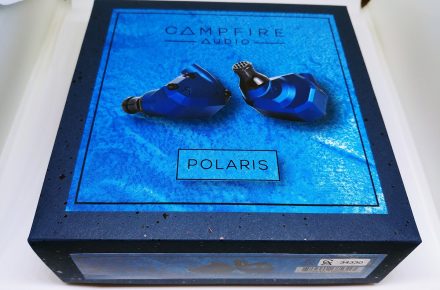
Blue sleeve that can be easily recognized from far.
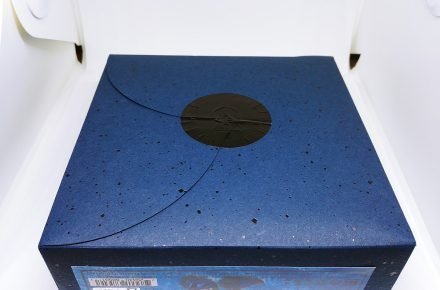
The sleeve is secured by a black round sticker
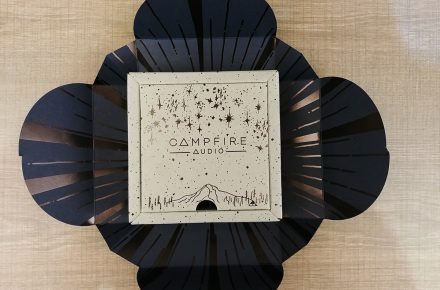
The box is nicely presented in a “galaxy” kind of feel

There is a Campfire Audio Logo printed in the inner side of the sleeve
Opening the box, you will find a blue leather case with the Polaris V2 sitting inside. There is a major change in the case - it looks like a blue curry puff (I like this description, it is from one of my co-worker). I like the new case. It is more spacious as compared to the squarish case.

The blue curry puff

The actual curry puff
There is actually an underlying reason behind this specific case design - to give back to society. According to Jayden, the case is crafted by a handicapped case manufacturer and Campfire Audio uses his case to support him.
Besides the case, you will find an accessories box. These are the accessories in the box:
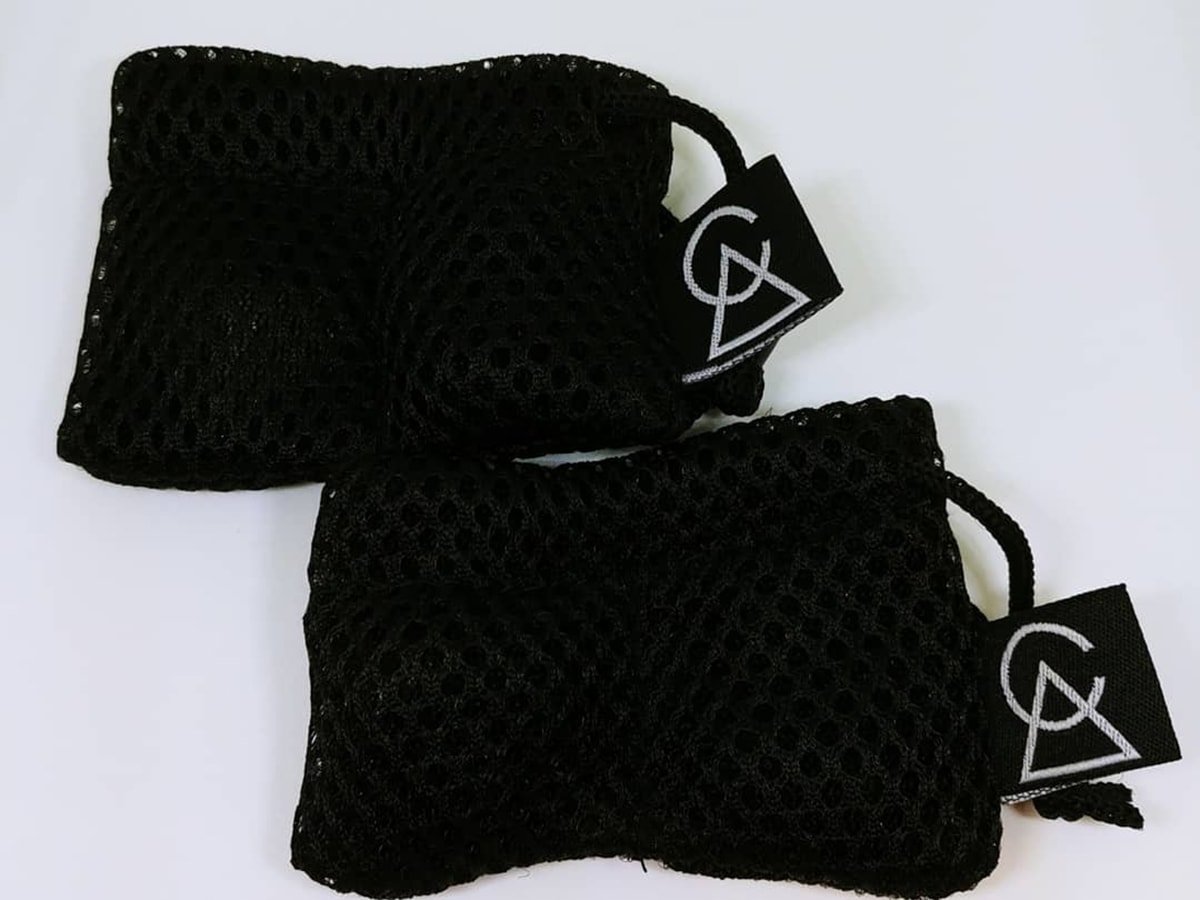
Campfire Audio mesh IEM bag
Technical Specifications
The Polaris V2 features a ’Cerulean’ Blue anodized finish with black PVD screws on a machined aluminum body. The color is very eye-catching. I fall in love with it on the first-sight - simply lovely.
The anodized body has a better resistance towards scratches. I believe Campfire Audio fans always face this issue - IEMs with a lot of scratches. Within the 2 months of usage, it had remain scratch-free.
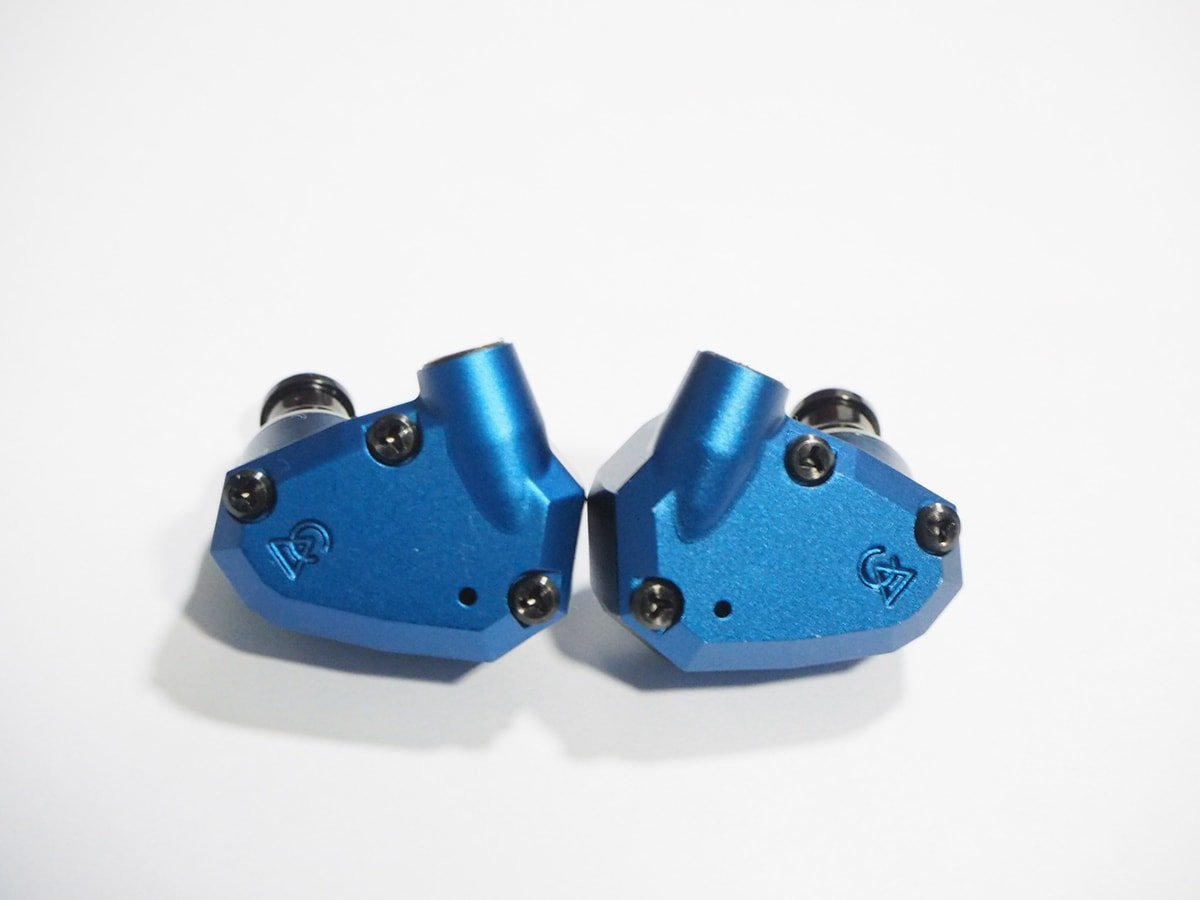
A close look on Campfire Audio Polaris V2
Besides the improvement on the shell, Campfire Audio improves the MMCX port. Custom beryllium-copper insulated round MMCX connector is used on the IEMs. Tested and proven, the MMCX connector gives me a satisfactory “click” whenever I attach the cable.
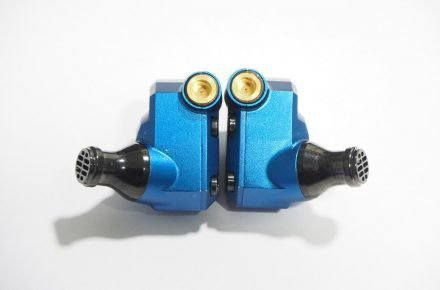
Custom beryllium-copper insulated round MMCX connector
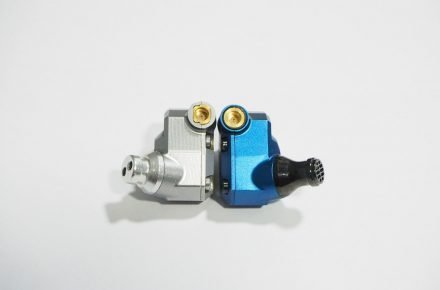
A comparison to show the difference in MMCX connector
The Polaris V2 has a black stainless steel spout or nozzle which improve the durability of the nozzle. As I mentioned in my previous review for Simgot EK3, the connector and the nozzle are the weakest points on the IEMs and the implementations successfully improve the overall build quality.
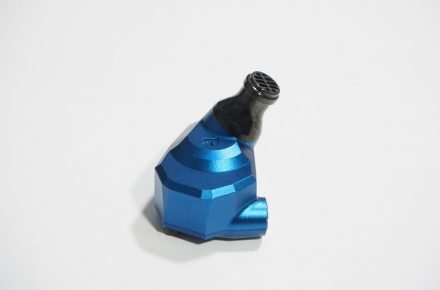
A close look at the nozzle
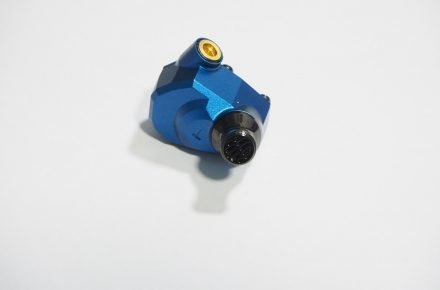
The front view of the nozzle
The cable included in the case is the new Smoky Litz Cable. Building from ALO Audio Silver Plated Copper Litz wire conductors and tangle-resistant twisted cable weave from Silver Litz and Super Litz cable, Campfire Audio added a new stylish Smoky jacket to compliment the unique finish of their new line of earphones.
Smoky Litz cable has a new light-weight molded ear-hook design replaces the memory wire. The result is a lightweight cable that is a pleasure to use every day.
This could be the greatest news for audiophiles who are wearing spectacles like myself. Memory wire ear-hook design is disastrous for us. For those cables with memory wire ear-hook, the memory wire constantly hit on the spectacles when we are moving. This creates a “microphonics-like” noise. Besides the noise, it is hard for us to shape the ear-hook due to the presence of spectacles. The new cable saves us from hell.
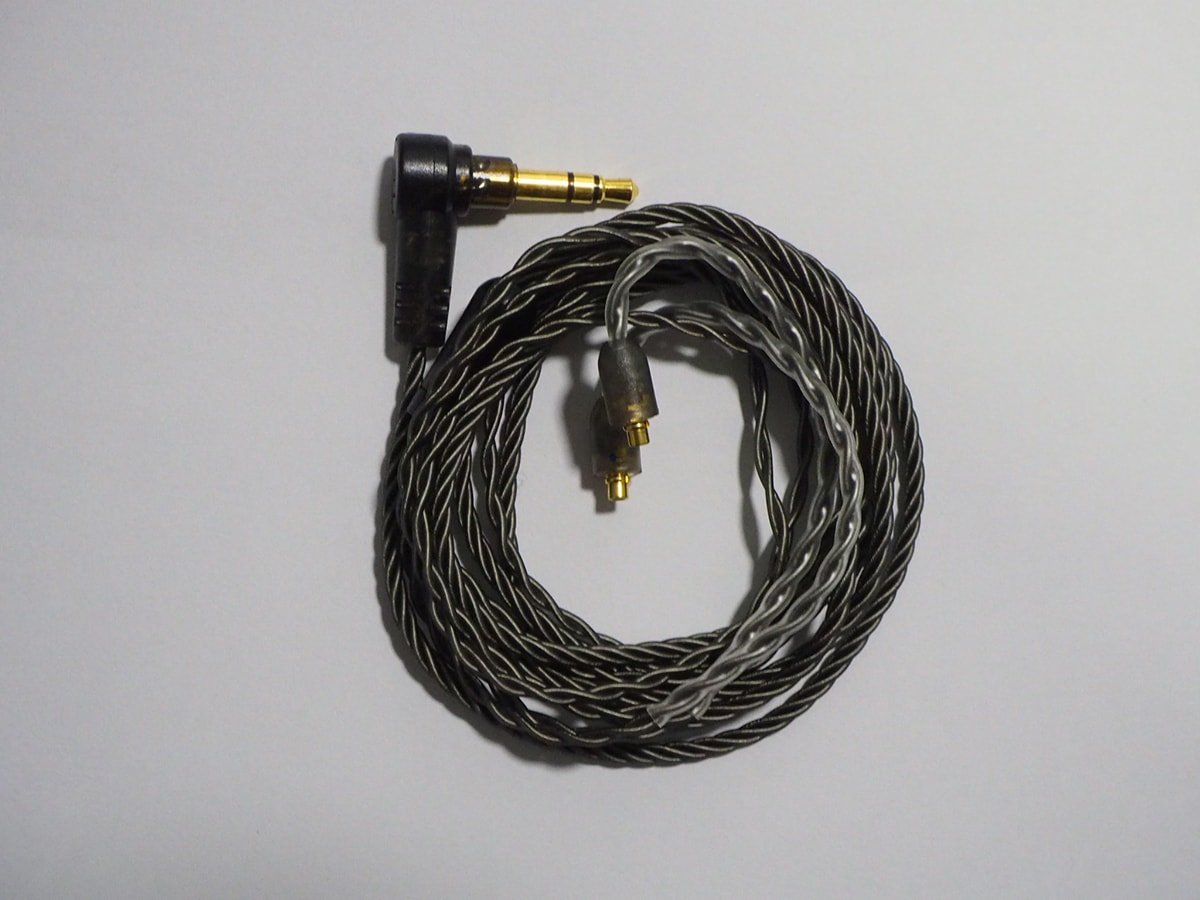
New smoky litz cable
Fit and Isolation
Polaris V2 has the typical shell shape as the previous releases of Campfire Audio. There are some slight changes - weight and edges. Due to the change in material, the new shell is lighter in weight as compared to the previous releases. There are less sharp edges in Polaris V2 and this yields a more comfortable wearing. I can wear Polaris V2 for hours without an issue.
The isolation for Polaris V2 is above average. When commuting, I can immerse myself in the music by turning the volume slightly higher as compared to normal listening. There is a vent at the faceplate of the IEMs to minimize dynamic driver-flex. This does not affect the isolation.
Driver flex is when the driver bends due to the pressure of air against it. Usually, it occurs when you're inserting the IEM into your ear and air in the shell creates pressure to bend the driver.
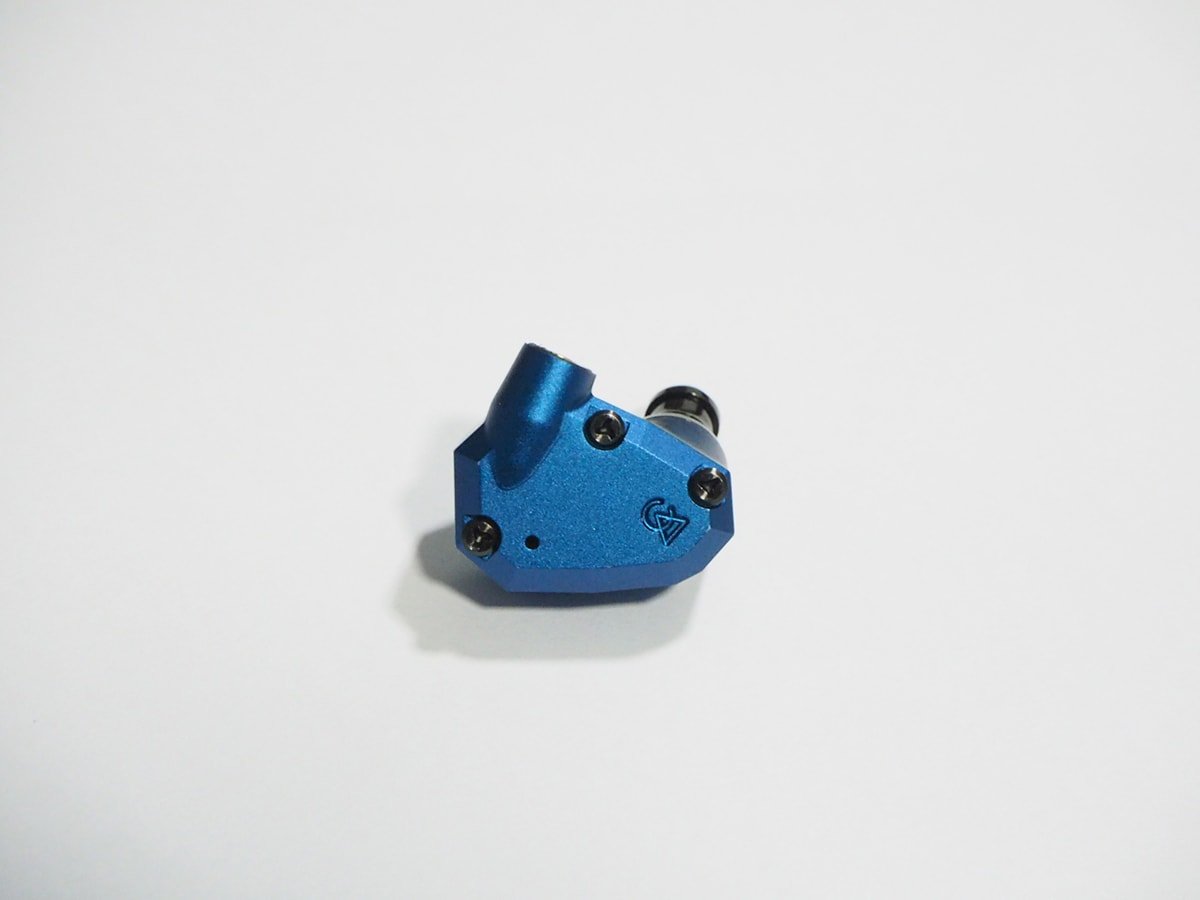
There is a vent on the faceplate
Pairing
For this review, I paired the Campfire Audio Polaris V2 with my daily Digital Audio Player (DAP) - Opus #3. I used Symbio ear tips by MandarinEs for this review.
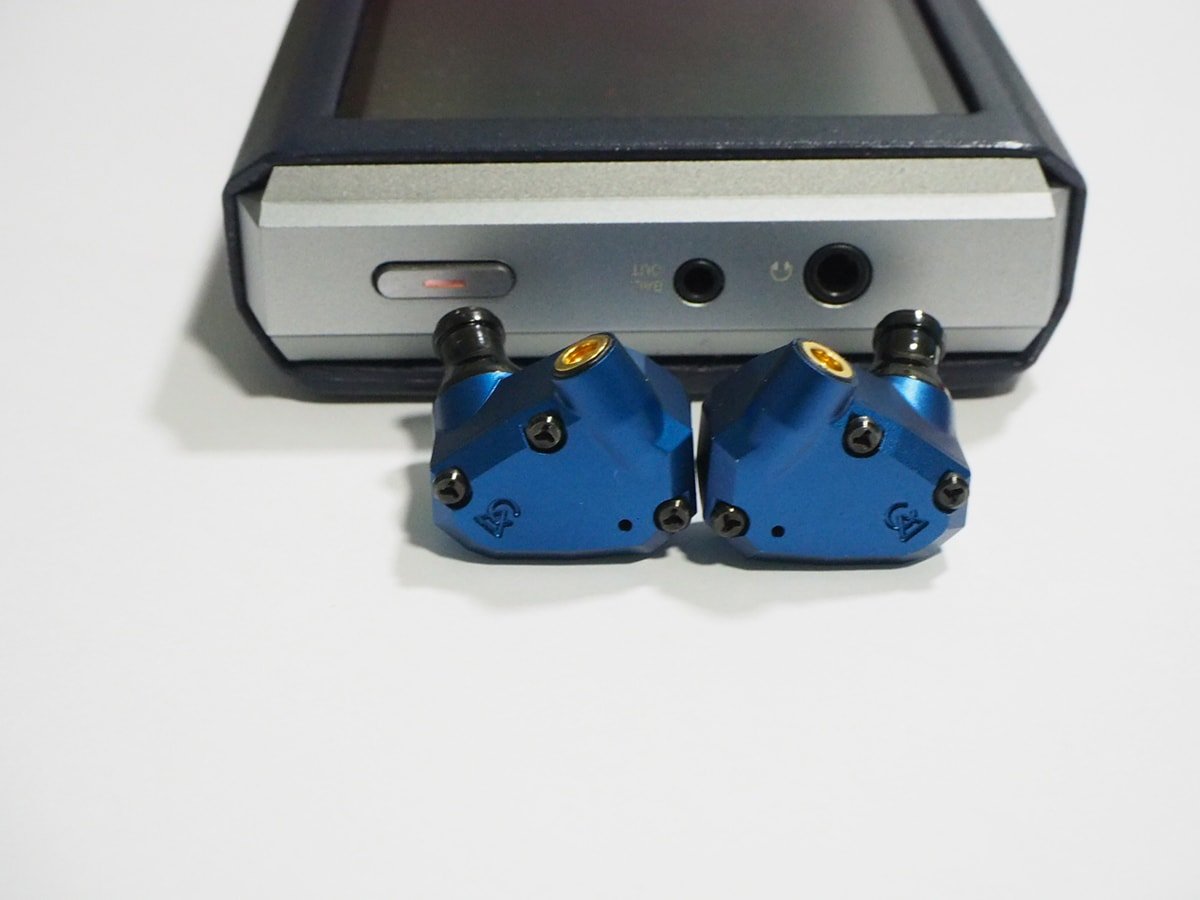
Polaris V2 hooked on Opus #3
Sound
It is always fun to listen to Polaris V2. I have to control myself not to dance in public.
Exhibiting the same sound signature from V1.0, the new Polaris V2 has a fun sound signature. However, it no longer has the “V” shaped sound signature. The sound stage has changed in this release and I think it is a great improvement. I will further elaborate in the upcoming sections.
This is a very different IEMs as compared to other Campfire Audio models - this IEM emphasizes a lot in the emotion. It is smooth and lush. I like the warmth injected in the overall presentation. It gives every note a soul and everything becomes lively.
The soundstage is always handy for Campfire Audio. Without a doubt, it ticks the box in my expectation sheet towards Polaris V2. It is wide and deep - as deep as an ocean. This could be the deepest I can get within the price range. I always like the depth in my Empire Ears Bravado and Polaris V2 beat it with an uppercut from way down deep.
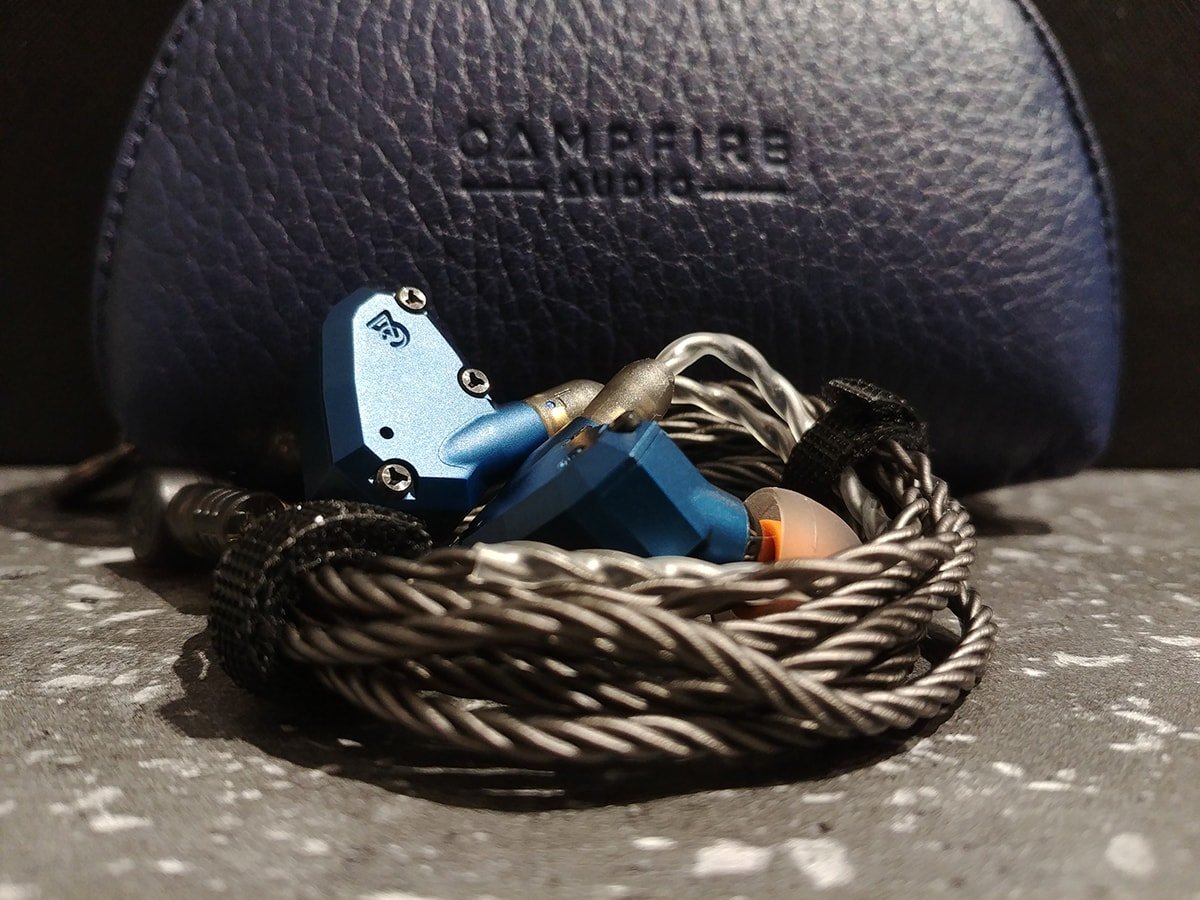
Campfire Audio Polaris V2
Lows
If you read my previous reviews, I always find the “secret weapon” in every IEMs. “Secret weapon” is the unique selling point for a particular model which distinguish it out from the pools of choices. Some people use “wow” factor to describe this. For Polaris V2, the lows will definitely be the “secret weapon”.
Rumble is not accurate enough to describe the lows. An earthquake would be more apt.
This is no exaggeration. It is indeed an earthquake when the lows kick in. It is so full, rich and deep. It is like a subwoofer embedded in the IEMs and it creates the waves that awaken your eardrums - making them vibrate together with the subwoofer.
The attack and decay speed of the lows is average. It is well controlled in its own region and the decay speed is in the sweet spot between bleeding to other regions and being too technical or “dry”. The quality of lows can easily fulfill the craves of a bass-head.
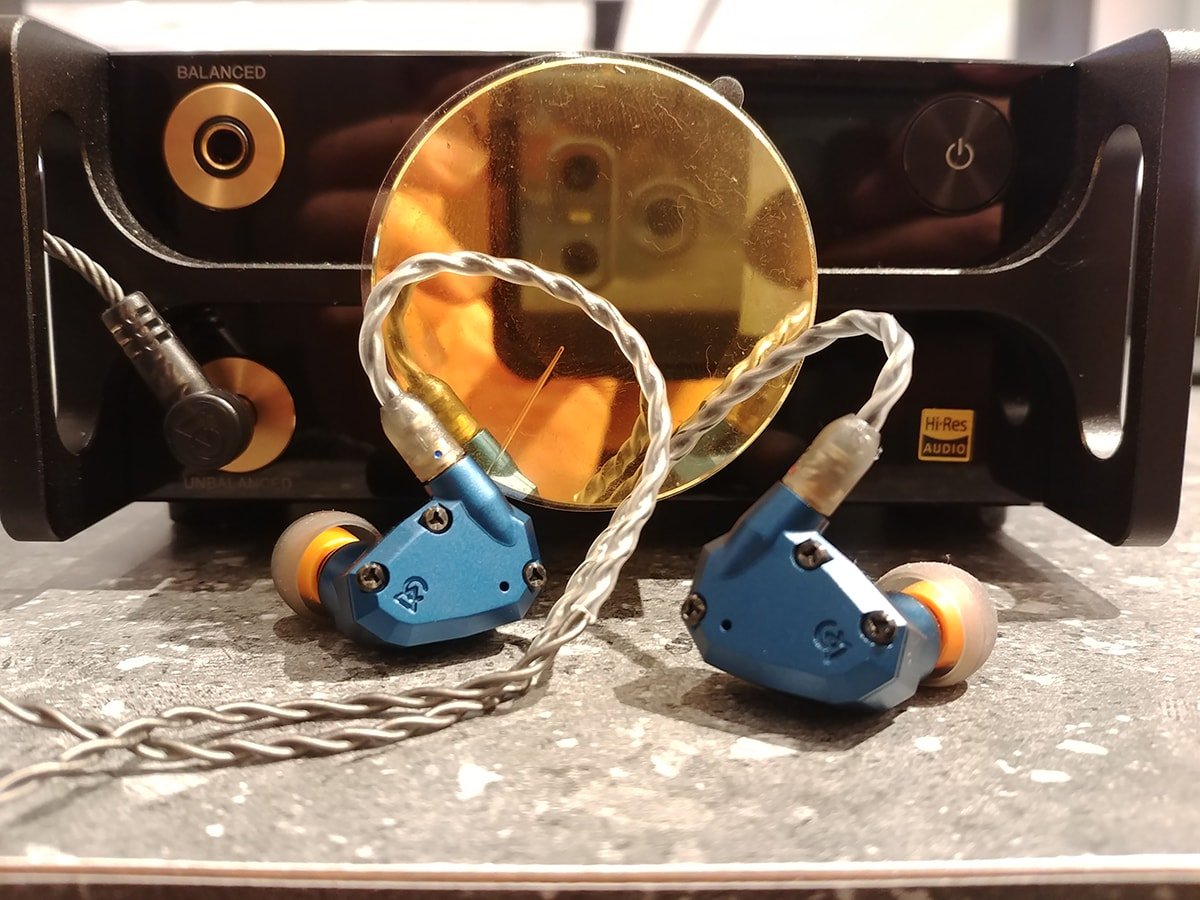
Campfire Audio Polaris V2 with Sony DMP-Z1
Mids
This is the area where the Polaris V2 improved as compared to the previous version. In the new Polaris V2, the mids are more forward - at the center of the stage, having the spotlight shining on it. This positioning is my favorite because I love pop music. The mids is very important to me and I really appreciate this sound stage.
The vocals are warm - full of emotion and it is comfortable to listen to. The body is full and I always prefer a fuller and richer vocal presentation than an airy one. The airy vocal is like sea breeze hitting softly in your face while a rich vocal is like a glass of warm milk sliding down your throat. All these are personal preference and I believe every type of presentation has its own fans.
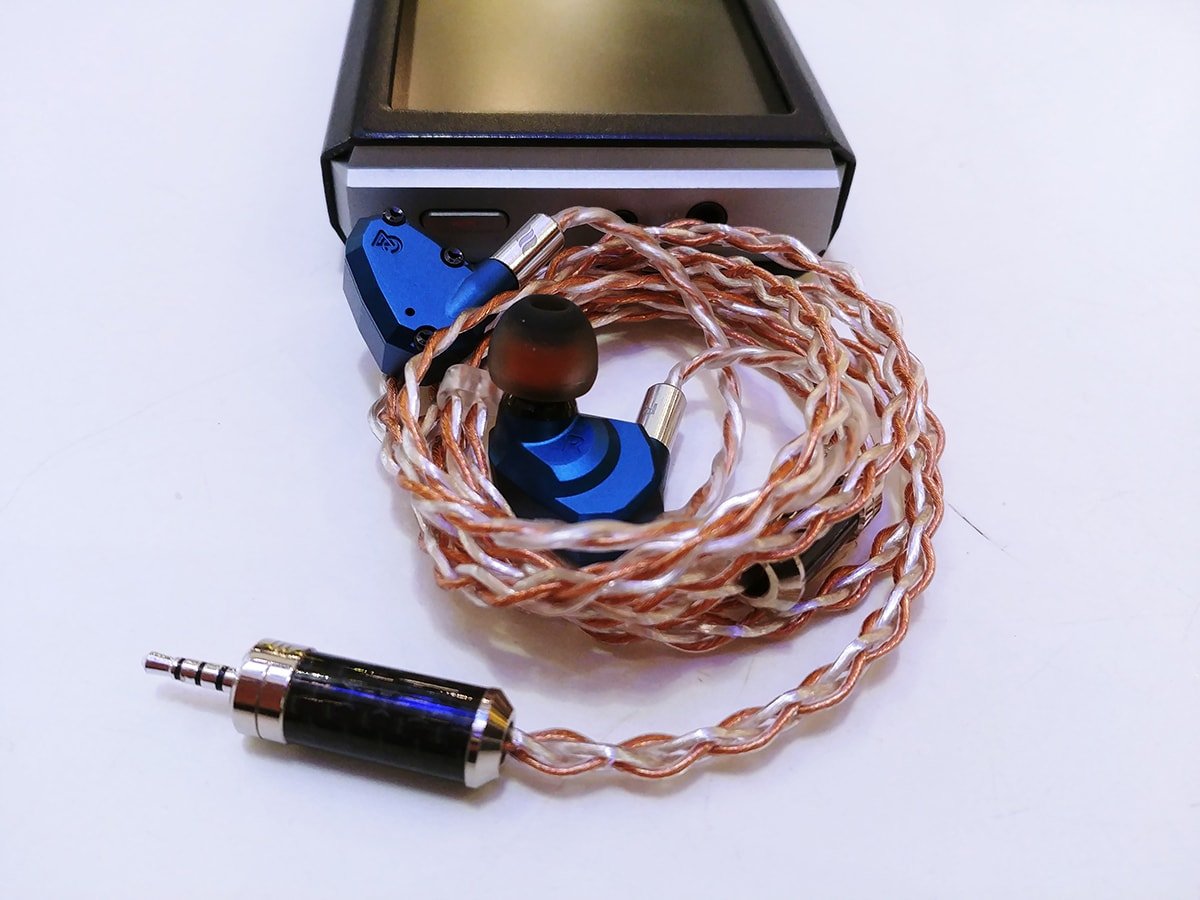
Did some cable rolling with Polaris V2
Highs
With the T.A.E.C implementation in the BA driver, highs is not an issue for Polaris V2 - well extended with sufficient amount of air. Highs is always not an issue for Campfire Audio except for Nova - highs rolled-off too early.
The well-extended highs improved the overall fidelity of the presentation and also thanks to the highs, it prevented the overall sound signature from being too warm. The air and slight sparkle balanced off the emphasis in the lows. The weight will not topple to the lows side too much.
Is the highs sharp and peaky? This is a tricky question for me to answer because I have very good tolerance towards treble. I will answer no. The highs is very gentle towards my eardrums. No harsh and no piercing even after long listening.
It is like a wave hitting on the beach and no tsunami. Everything is fine.
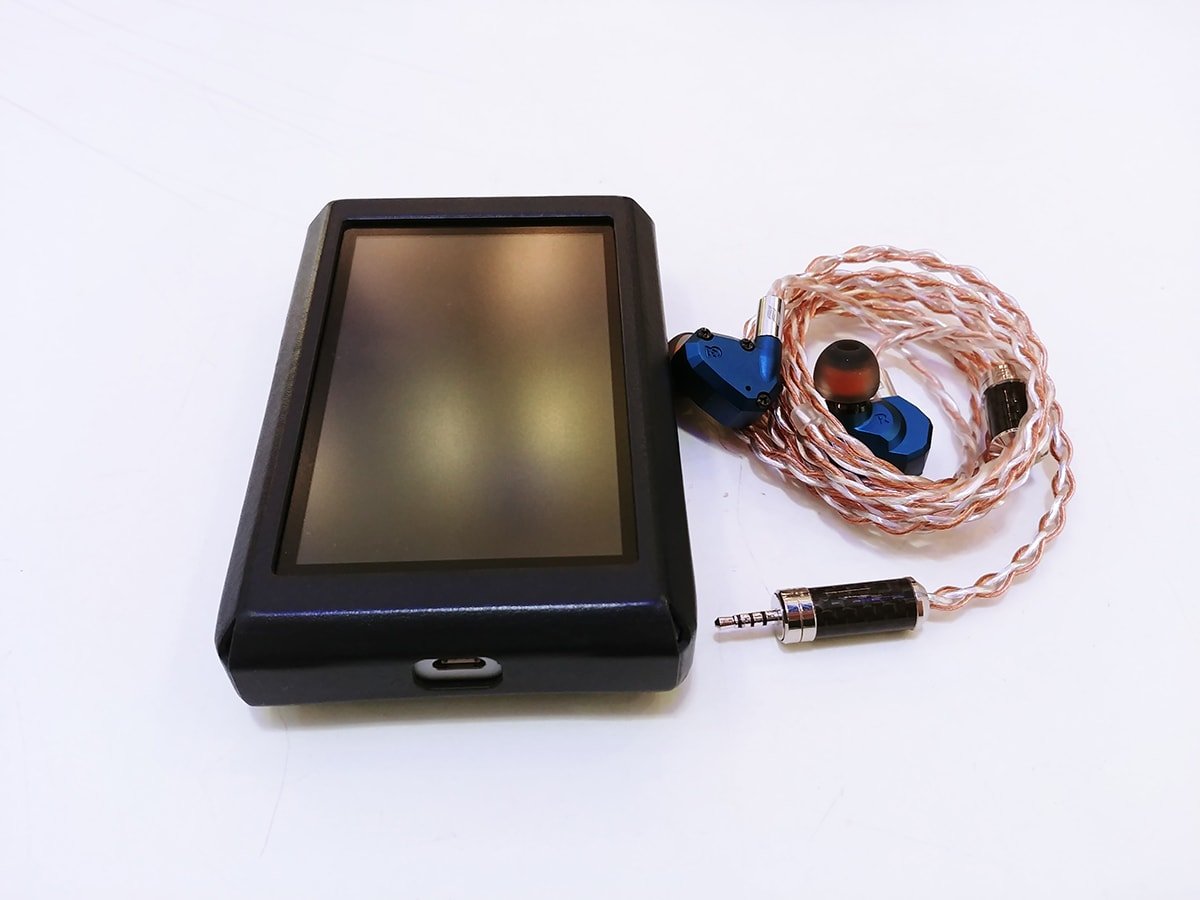
Campfire Audio Polaris V2 with Effect Audio Eros II hooked on Opus #3
Conclusion
The Campfire Audio Polaris V2 is a great choice for audiophiles who are looking for a mid-tier IEM with quality bass that rumbles the ground. Polaris V2 can definitely satisfy your craves in bass. This release poses a potential threat to a lot of other models from other brands which have same configurations such as Empire Ears Bravado.
Polaris V2 retails for USD $499. It can be purchased from the official Campfire Audio website and for those who reside in Singapore can drop by ConnectIT by Jade Gift Shop to make a purchase.
Outstanding performance from Polaris V2 has convinced me to change my daily driver. My Nova is now officially retired.
Disclaimer
This review is originally posted on Headphonesty. Thanks to Jayden from ConnectIT and Campfire Audio for sending the Campfire Audio Polaris V2. The product was provided to me free of charge in exchange for my honest review and opinion.
Introduction
Campfire Audio announced the launch of two new models - Campfire Audio Polaris V2 and Campfire Audio IO during Fujiya Avic Headphone Festival 2019. After the launch in Japan, I had the opportunity to work with a distributor to launch these two models in Singapore. This is an amazing experience for me because of the support from the Campfire Audio fans.
I have been impressed by Campfire Audio since the first launch of Orion, Jupiter and Lyra and also had some experience with the previous generation of Polaris V2. It is a fun “V” shaped in-ear monitors (IEMs). The sound signature had changed significantly in this new version of thePolaris V2.
Is it an improvement? Absolutely. Read on to find out why.

Campfire Audio Polaris V2

Polaris V2 and IO launch in Singapore - Spot me in the photo!
Unboxing
The packaging for Campfire Audio is like a child. It grows across the releases.
I compared the new packaging with my pioneer generation packaging from Campfire Audio Nova and the differences are significant. The new packaging is more grand and classy as compared to the old packaging which focuses more on simplicity.
Campfire Audio changed their design approach of the box and IEMs - mainly on the color theme. Now the box, case, and IEMs will have the same color. You can identify the models from far based on either the box, case or the shell color immediately. The palette of choice for Polaris V2 is one of my favorite - Blue.
The outer layer of the packaging is a sleeve with a sticker which consists of the IEMs, model, and brand. The sleeve can be opened up by removing the small round sticker at the back of the sleeve.
After opening the sleeve, the presentation of the inner box is amazing. The inner box “shines” in the galaxy and it is the only focus. Words cannot describe the beauty.

Blue sleeve that can be easily recognized from far.

The sleeve is secured by a black round sticker

The box is nicely presented in a “galaxy” kind of feel

There is a Campfire Audio Logo printed in the inner side of the sleeve
Opening the box, you will find a blue leather case with the Polaris V2 sitting inside. There is a major change in the case - it looks like a blue curry puff (I like this description, it is from one of my co-worker). I like the new case. It is more spacious as compared to the squarish case.

The blue curry puff

The actual curry puff
There is actually an underlying reason behind this specific case design - to give back to society. According to Jayden, the case is crafted by a handicapped case manufacturer and Campfire Audio uses his case to support him.
Besides the case, you will find an accessories box. These are the accessories in the box:
- Final Audio Tips (Five sizes from XS to XL)
- Campfire Audio Marshmallow Tips (Three sizes from S to L)
- Silicone Earphone Tips (Three sizes from S to L)
- Campfire Audio Lapel Pin
- Cleaning Tool

Campfire Audio mesh IEM bag
Technical Specifications
- 5Hz–20kHz Frequency Response
- 105 dB SPL/mW Sensitivity @ 1k
- 17 Ohms @ 1kHz Impedance
- Single Balanced Armature + tuned acoustic expansion chamber(T.A.E.C.™)
- 9.2mm Dynamic Driver + Polarity Tuned Chamber™
- Newly Insulated Custom Beryllium / Copper MMCX Connections
- ‘Cerulean’ Blue Anodized Aluminum Body
- Black PVD Screws
- Black Stainless Steel Spout
The Polaris V2 features a ’Cerulean’ Blue anodized finish with black PVD screws on a machined aluminum body. The color is very eye-catching. I fall in love with it on the first-sight - simply lovely.
The anodized body has a better resistance towards scratches. I believe Campfire Audio fans always face this issue - IEMs with a lot of scratches. Within the 2 months of usage, it had remain scratch-free.

A close look on Campfire Audio Polaris V2
Besides the improvement on the shell, Campfire Audio improves the MMCX port. Custom beryllium-copper insulated round MMCX connector is used on the IEMs. Tested and proven, the MMCX connector gives me a satisfactory “click” whenever I attach the cable.

Custom beryllium-copper insulated round MMCX connector

A comparison to show the difference in MMCX connector
The Polaris V2 has a black stainless steel spout or nozzle which improve the durability of the nozzle. As I mentioned in my previous review for Simgot EK3, the connector and the nozzle are the weakest points on the IEMs and the implementations successfully improve the overall build quality.

A close look at the nozzle

The front view of the nozzle
The cable included in the case is the new Smoky Litz Cable. Building from ALO Audio Silver Plated Copper Litz wire conductors and tangle-resistant twisted cable weave from Silver Litz and Super Litz cable, Campfire Audio added a new stylish Smoky jacket to compliment the unique finish of their new line of earphones.
Smoky Litz cable has a new light-weight molded ear-hook design replaces the memory wire. The result is a lightweight cable that is a pleasure to use every day.
This could be the greatest news for audiophiles who are wearing spectacles like myself. Memory wire ear-hook design is disastrous for us. For those cables with memory wire ear-hook, the memory wire constantly hit on the spectacles when we are moving. This creates a “microphonics-like” noise. Besides the noise, it is hard for us to shape the ear-hook due to the presence of spectacles. The new cable saves us from hell.

New smoky litz cable
Fit and Isolation
Polaris V2 has the typical shell shape as the previous releases of Campfire Audio. There are some slight changes - weight and edges. Due to the change in material, the new shell is lighter in weight as compared to the previous releases. There are less sharp edges in Polaris V2 and this yields a more comfortable wearing. I can wear Polaris V2 for hours without an issue.
The isolation for Polaris V2 is above average. When commuting, I can immerse myself in the music by turning the volume slightly higher as compared to normal listening. There is a vent at the faceplate of the IEMs to minimize dynamic driver-flex. This does not affect the isolation.
Driver flex is when the driver bends due to the pressure of air against it. Usually, it occurs when you're inserting the IEM into your ear and air in the shell creates pressure to bend the driver.

There is a vent on the faceplate
Pairing
For this review, I paired the Campfire Audio Polaris V2 with my daily Digital Audio Player (DAP) - Opus #3. I used Symbio ear tips by MandarinEs for this review.

Polaris V2 hooked on Opus #3
Sound
It is always fun to listen to Polaris V2. I have to control myself not to dance in public.
Exhibiting the same sound signature from V1.0, the new Polaris V2 has a fun sound signature. However, it no longer has the “V” shaped sound signature. The sound stage has changed in this release and I think it is a great improvement. I will further elaborate in the upcoming sections.
This is a very different IEMs as compared to other Campfire Audio models - this IEM emphasizes a lot in the emotion. It is smooth and lush. I like the warmth injected in the overall presentation. It gives every note a soul and everything becomes lively.
The soundstage is always handy for Campfire Audio. Without a doubt, it ticks the box in my expectation sheet towards Polaris V2. It is wide and deep - as deep as an ocean. This could be the deepest I can get within the price range. I always like the depth in my Empire Ears Bravado and Polaris V2 beat it with an uppercut from way down deep.

Campfire Audio Polaris V2
Lows
If you read my previous reviews, I always find the “secret weapon” in every IEMs. “Secret weapon” is the unique selling point for a particular model which distinguish it out from the pools of choices. Some people use “wow” factor to describe this. For Polaris V2, the lows will definitely be the “secret weapon”.
Rumble is not accurate enough to describe the lows. An earthquake would be more apt.
This is no exaggeration. It is indeed an earthquake when the lows kick in. It is so full, rich and deep. It is like a subwoofer embedded in the IEMs and it creates the waves that awaken your eardrums - making them vibrate together with the subwoofer.
The attack and decay speed of the lows is average. It is well controlled in its own region and the decay speed is in the sweet spot between bleeding to other regions and being too technical or “dry”. The quality of lows can easily fulfill the craves of a bass-head.

Campfire Audio Polaris V2 with Sony DMP-Z1
Mids
This is the area where the Polaris V2 improved as compared to the previous version. In the new Polaris V2, the mids are more forward - at the center of the stage, having the spotlight shining on it. This positioning is my favorite because I love pop music. The mids is very important to me and I really appreciate this sound stage.
The vocals are warm - full of emotion and it is comfortable to listen to. The body is full and I always prefer a fuller and richer vocal presentation than an airy one. The airy vocal is like sea breeze hitting softly in your face while a rich vocal is like a glass of warm milk sliding down your throat. All these are personal preference and I believe every type of presentation has its own fans.

Did some cable rolling with Polaris V2
Highs
With the T.A.E.C implementation in the BA driver, highs is not an issue for Polaris V2 - well extended with sufficient amount of air. Highs is always not an issue for Campfire Audio except for Nova - highs rolled-off too early.
The well-extended highs improved the overall fidelity of the presentation and also thanks to the highs, it prevented the overall sound signature from being too warm. The air and slight sparkle balanced off the emphasis in the lows. The weight will not topple to the lows side too much.
Is the highs sharp and peaky? This is a tricky question for me to answer because I have very good tolerance towards treble. I will answer no. The highs is very gentle towards my eardrums. No harsh and no piercing even after long listening.
It is like a wave hitting on the beach and no tsunami. Everything is fine.

Campfire Audio Polaris V2 with Effect Audio Eros II hooked on Opus #3
Conclusion
The Campfire Audio Polaris V2 is a great choice for audiophiles who are looking for a mid-tier IEM with quality bass that rumbles the ground. Polaris V2 can definitely satisfy your craves in bass. This release poses a potential threat to a lot of other models from other brands which have same configurations such as Empire Ears Bravado.
Polaris V2 retails for USD $499. It can be purchased from the official Campfire Audio website and for those who reside in Singapore can drop by ConnectIT by Jade Gift Shop to make a purchase.
Outstanding performance from Polaris V2 has convinced me to change my daily driver. My Nova is now officially retired.
Zelda
Headphoneus Supremus
Pros: Build quality
Unique design
Cable
Powerful bass tuning
Accessories
Unique design
Cable
Powerful bass tuning
Accessories
Cons: Sharp design may present comfort issues
Average isolation; wind noise
Heavy bass specific tuning
Average isolation; wind noise
Heavy bass specific tuning
The package inside is tightly organized with a new set of accessories. The earphones arrive inside a leather like case, and in the case of the Polaris, in a sleek cerulean blue color. Admittedly, the new case looks more like a small lady purse than won’t be easily overlooked compared to more standard cases. A new take from Campfire Audio that may or may not suit everyone. The smaller rectangular box holds two sets of dual mesh pouches with various sets of ear tips. There are five sets of final E silicone tips, three pairs of standard tips and three pairs of memory foam tips. Also a cleaning tool, and of course, the little Campfire Audio pin.Design
As usual for Campfire Audio earphones they combine a strong build quality with very eye-catching design. The shells main body is made of tough anodized machined aluminum material painted in cerulean blue color giving a beautiful metallic finish. Even though, the paint may get off after some short time, especially with the various sharp sections on the shells; using the dual mesh bags is recommended to avoid unnecessary scratches when sorting the earphones. The earpieces consist of two outer and inner parts strongly attached by the metal black PVD coated screws, giving an even more cool look to them. The nozzle is now stainless steel and in this case arrives in black color. Instead of bores, there are instead small grills. Despite the all metal design, the shells remain light and comfortable to wear. With the hybrid drivers’ setup, there is a small hole at the front side which should act as a vent for the dynamic driver inside. It does affect the isolation level to be around average and wind noise can be heard too.
The shape is the typical one for many of the Campfire line, that while being very unique it has many sharp corners. The fit is still easy for a strict over-ear wearing IEM. The right position should be with the ‘CA’ logo horizontally lined. However, these are not small shells and the sharp design can be uncomfortable. Even so, with the slim and longer nozzle it is possible to achieve a less obtrusive fit with less contact to the ear skin. Not going to win in terms of comfort but can still be used all day long.
For the detachable cable connection the Polaris has been updated to the newer MMCX copper coated sockets introduced on the last models. The cable is also a new model from the company, a standard braided four strands cable made of silver-plated litz wires. The MMCX plugs are beryllium coated and strongly attached to the earphones sockets. There are fixed ear guides over the previous memory wire used, but they are very soft to even be noticed.
Sound Quality
The Polaris sound has one single main goal, BASS. It is advertised as such and it is probably one of the most bass heavy tuned in-ear monitors I’ve tried, and undoubtedly the only one with such a strong focus on the lows for a relatively mid-tier IEM. It is not about having a fair balance with added emphasis on the lows, rather a powerful dynamic driver acting as a whole woofer that takes all the attention. The bass is extreme, voluminous and unforgiving, clearly an excellent match for true bass heads. In terms of bass balance, it is a bit more lifted on the mid-bass, but sub-bass is just as present with good depth. Of course, the layering and separation are affected and it can get out of control. Upper bass reaches to the whole midrange giving a dark tonality overall. However, there is still quality here, once paired with a very good source. The bass has speed, fast and aggressive attack with a slow deep decay. The sub and mid bass can be well differentiated and the extension is pretty good. Equalization does work on the Polaris, but only if meant to tame it a little bit, otherwise it would lose the whole meaning of its sound tuning.
The small balanced armature unit inside still sounds very well on its own, with good clarity and resolution on midrange and treble, very little coloration and fairly neutral. It may depend on the sources used, as sometimes the Polaris may sound a bit more v-shaped, but never reaching the voluminous enhanced lows that would arrive from the dynamic part.
The midrange is surely more distant, without much body on and lack some dynamism. It is still accurate and decently articulated in the usual BA fashion. Instruments are well separated; the lack of air is due the power dynamic driver bass than a limitation of the BA unit. Voices are detailed and inoffensive, but again will sound overshadowed by the whole bass.
Highs are similarly present on the mix. Not particularly laid-back though never will stand out. They sound subjectively rather linear; there is no peak or harshness at least on moderate safe listening volume. As a single balanced armature the extension is limited and a certain roll-off can be perceived. The resolution is fine, just nothing fantastic; retrieval of detail is decent for a heavy bass tuning, though will lose next to better ‘balanced’ IEMs.
The Polaris sound is large. Not too wide but gives a good sense of distance. The lack of midrange presence helps in this regard too, however the too strong bass impact affects the correct positioning of elements. A ‘fun’ type of sound only for those looking for huge amounts of bass without the rich and fullness on the midrange and sparkle on the highs.
Last edited:
B9Scrambler
Headphoneus Supremus
Pros: Updated build/paint job, cable, and accessories - Sound stage and midrange - Price drop
Cons: Not as detailed and clear as the original - Wind noise
Greetings!
Today we're checking out the new, reworked version of the Polaris from Campfire Audio.
Back in 2017 when I reviewed the original Polaris, I was blown away. Here was an earphone that was quite technically adept in a way that was befitting of it's premium price tag, yet it had an unashamedly v-shaped signature. It was both fun and capable, yet there were a few qualities I was not particularly fond of. First, while the sound stage was large it was quite flat giving the Polaris a “wall of sound” effect. Over time I also found the mid-range could come across dry and unnatural. Regardless, it made for one heck of a listen, all wrapped with that distinctive Campfire Audio design.
The new Polaris is now available and I've spent the last two months rocking out to it. Is it an upgrade over the original? Does it paste the same stupid grin across my face when listening to EDM? Or, was it downgraded to fall in line with the 100 USD lower price? Let's find out.
Disclaimer:
Thanks to Caleb with Campfire Audio for arranging a sample of the Polaris for the purposes of review. The thoughts within this review are my own subjective opinions based on time spent listening to the Polaris throughout the last two months. They do not represent Campfire Audio or any other entity. At the time of writing the Polaris retailed for 499 USD. You can check it out here: https://campfireaudio.com/shop/polaris-2/
Originally posted on https://thecontraptionist.blog.
**Edit: Score reduced a full point/star as the Polaris II now has plenty of competition that can keep up at a lower price point. Still hellishly fun though, and worth it if you want an attractively designed, mid-tier bass cannon.**
Personal Preference:
I listen primarily to various EDM sub-genres (liquid drum and bass, breakbeat, drumstep, etc.), hip hop, and classic rock. My preferences for earphone tuning are quite relaxed and as such their is no one signature I look for. The HiFiMAN RE800, Brainwavz B400, and Massdrop x MeeAudio Planamic are examples of earphones with wildly varied signatures that are enjoyable for different reasons. I generally listen at very low volumes, so keep this in mind when perusing my thoughts on how an earphone sounds.
Sources:
Mobile: Shanling M0 alone or with the Periodic Audio Ni amp, ZiShan DSD
@home: TEAC HA-501 with a ZiShan DSD or Asus FX53V acting source duty
The Polaris II is quite sensitive and easy to drive. No amp needed. Make sure you've got a clean source though, because like many Campfire iems it will hiss if the output is too much.
Specifications:
Packaging and Accessories:
When it comes to packaging, Campfire Audio has changed things up this time around. The spirit of their past designs are still in place as they follow the same astronomical theme, but the format has changed. Similar to the Solaris, the Polaris comes in a fairly large, shallow square box. This box is covered by an exterior sheath, sealed shut by a bronzed black Campfire Audio seal on the back. The front contains a large sticker with a mottled pattern set beneath a high quality image of the Polaris' earpieces and the usual company branding and model information. One more sticker is present around the side containing company info, another image of the Polaris, among other details that may or may not be important to the average consumer.
Breaking the seal, the sheath unfold like the pedals of a flower revealing the main box inside. Lifting out the box, you will notice the inner sheath is printed with the CA logo dead centre, blackened rays exploding outwards. It's quite dramatic. The main box itself contains the same beautiful mountainous scene found on CA's prior packaging along with more Campfire Audio branding. Lifting the lid you're greeted by the slogan “Nicely Done” printed on one of the flaps, as well as their new leather carrying case and a smaller cardboard box containing many of the included accessories. Beneath all this is your warranty card and a manual. In all you get:
Packaging aside, the accessory kit is second to none. Final Audio tips are some of the best in the business and with five sizes included you're sure to find something that works for your ears. Campfire Audio's Marshmallow tips are a very high quality foam option. The basic single flange silicone tips are nothing special and are the sort of tip you'd find included with more budget oriented offerings. That's not to take away from their performance though. They stay attached to the nozzle just fine and consistently seal well. The cleaning tool will be invaluable to those with waxy ears and the inclusion of three mesh bags to keep everything neatly organized is genius. Nicely done.
Build, comfort, and Isolation:
The machined aluminum housings of the new Polaris eschew the Ceracote faceplates of the original, and instead are adorned completely with a vibrant blue anodized finish that looks pretty stunning in person. Seems to me that Campfire has improved the quality of their machining and their anodized finish. Compared to the original Polaris, the shells are much smoother. Small bumps and knocks that chipped the finish on the original Polaris have done nothing to the Polaris II. Black ~10mm long stainless steel nozzles replace the 3D printed plastic nozzles of the original Polaris and have a prominent lip that does a great job of holding tips in place. These nozzles are very similar to those introduced with the Atlas and Comet and incorporate protective grills into the design. You won't have to worry about losing a filter when changing tips. Matte black screws top things off and attractively accent the blue colouring. I would love to paint them yellow to give the Polaris a Subaru WRC vibe. The Polaris II carries over Campfire Audio's familiar, extra durable, and newly insulated beryllium/copper MMCX connectors. I say extra durable because that's what the marketing blurb spouts, but also my now almost two year old and well-loved original Polaris has seen tens and tens of disconnects and the MMCX connectors are just as firm now as they were out of the box. Fit and finish is as to be expected, that is to say it is fantastic. Seams are barely visible and everything lines up perfectly without any gaps or off kilter angles.
The Polaris II comes with Campfire Audio's new Silver Plated Copper Litz cable. It is quite reminiscent in design and thickness to the copper cable that came with the original Polaris, but with a new smoke coloured sheath. The 90 degree angled jack is smartly designed with an extension to permit compatibility with a wide variety of device cases, though strain relief is a little stiff. Less of a worry than it would be in other cases. My experiences with Campfire's cables have shown them to be plenty durable. Within the small, reliefless aluminum y-split, the cable divides sending two strands on each side to the ear pieces. Slotting into the top of the split is a small plastic chin cinch. It moves much more smoothly here than on older Campfire cables and as a result is much more useful. Also much more useful is the move to preformed ear guides. While the memory wire used on past Campfire Audio cables worked, I found the “memory” aspect of that title limited at best which led to the wire straightening out over time. Ditching that entirely and running with preformed guides has resulted in a much more pleasant experience since I'm not constantly rebending the wire to ensure it stays behind my ear. This is a great new cable and I was pleased to see it included with some other new/updated models, like the IO and Andromeda v3.
When it comes to comfort you'd be forgiven for assuming Campfire Audio's iconic angular shell design is a pain in the ear. Maybe for some, but not for me. Ergonomics are just right with the low profile Polaris II conforming quite naturally to my outer ear. That plus the use of lightweight aluminum, a small size the belies the chunky appearance, and the reasonably long nozzle keeps the earphone sitting in a way that does not feel out of place. While I find the stubby nozzle of the Andromeda more suitable to my personal ear anatomy, I can still wear the Polaris for hours without experiencing any discomfort.
Isolation on the Polaris II is quite good. Despite having a vented housing, it blocks nearly as much noise as the fully sealed IO. However, the Polaris II retains the placement of the outer vent of the original and picks up a ton of wind noise that almost completely drowns out your music. While the volume of the wind noise is reduced over the original Polaris, it is still glaringly loud limiting the Polaris II's usefulness when worn outside, at least in weather where even a fairly light breeze is present.
Sound:
Tips: Wide bore all the way. The included small bore tips accentuate the already very prominent mid-bass tipping the Polaris II over the edge into a slightly bloated presentation. Wide bore tips, like those from JVC, negate this keeping the low end massive and engaging but still controlled.
While still very much a v-shaped sound, the Polaris II's tuning has seen some when changes compared to the original, the most obvious due to a new dynamic driver handling the low end. Gone is the original's 8.5mm dynamic is favour of a larger, 9.2mm unit. Boy, does it make a difference. The Polaris II's low end takes most of the spotlight and as such is a major driving force in the overall presentation. So, let's start by looking at the bass.
The Polaris II's low frequencies are huge. Lots of mid-bass, lots of sub-bass, bass everywhere. This new Polaris is an absolute bass cannon. Normally this quantity of bass would be a bit much for me, but it works. This new dynamic doesn't initially feel quite as quick as the old one but it handles the rapid double bass inherent in many metal tracks, such as Havok's “Time Is Up”, just as well as the old one. And, in the process it provides a MUCH more visceral experience with notes rumbling and lingering where they would die off and lose energy on the original Polaris. This makes tracks like Karma Fields & Morten's “Stickup ft. Juliette Lewis” an absolute blast thanks to the heavy bass line that now carries the track like it should. The only thing I prefer about the previous driver is it provides more texture and detail. The new Polaris II's low end is smoother and more refined at the expense of a mild loss of information.
Midrange presence is more or less the same as it was on the original. That is to say, it's recessed, but not by a lot. Despite all the extra bass dialed into the Polaris II, instruments and vocals remain clear and coherent without mid-bass bleed joining in and ruining the party. I personally prefer the mid-range here when compared to the original Polaris because it's thicker and more natural sounding with a more accurate timbre. I get a better sense of the emotion behind Paul Williams' opening and lyrics on Daft Punk's “Touch” with the Polaris II. However, this more natural presentation comes with a reduction in clarity and detail which is noticeable when a/b'ing the two together. Vocals simply do not sound as sharp and crisp through the Polaris II. I personally think this is worth the improvements in timbre and accuracy. You might feel otherwise.
The Polaris II is about as bright as the original, with the treble emphasis shifted to higher frequencies. This gives the II more energy and bite to its attack while adding air and space to notes. The reduction in the presence region would also help explain the slightly reduced detail and clarity. In addition to the shifted emphasis, I found the Polaris II's presentation better controlled. Running through King Crimson's “Cat Food”, hit hats simply sound cleaner and better defined through the Polaris II. If you're sensitive to upper treble, I can certainly see you preferring the original Polaris' presentation though as hit hats have a fair bit more emphasis through the Polaris II and at higher volumes risk being overbearing.
Lastly, the Polaris II has a wicked sound stage. While the original had a fairly tall stage, it lacked depth which resulted in a presentation that was more or less a wall of sound. The Polaris II is in my opinion miles ahead of the original in this regard. Running through BT's “If The Stars Are Eternal Than So Are You And I”, the Polaris II surrounds you within the ethereal effects and dancing sounds while the original Polaris merely places it beside you. Tracks are much more deep and lively with the Polaris II. Imaging is improved too thanks to this extra space, lending the Polaris II to success with gaming. The depth and accuracy of it's stage, along with excellent layering and separation made this earphone a gem to use when playing intense racing games like Wipeout Omega Collection (special mention goes to the wicked sound track) or competitive shooters like PUBG or Call of Duty.
Select Comparisons (volumes matched using Dayton iMM-6):
Fidue A85 Virgo (399.00 USD): The A85's triple driver hybrid setup offers a more balanced, neutral-leaning sound than the Polaris II. Treble on the A85 feel biased towards the presence region and compared to the Polaris II is lacking in brilliance. This leaves cymbals, chimes, etc. sounding slightly muted and dull compared to the Polaris, and lacking the same level of detail. The A85's mid-range is notably more forward with vocals and acoustics having a slightly thicker and much more dominant presence on most tracks. Timbre is more accurate out of the Polaris II. The A85 adds a touch of dryness where there should be none. Clarity is similar between the two with vocals and instruments being equally coherent. Bass is where the two drastically split. The A85's low end is barely elevated above neutral with a light, warm, mellow presence that focuses clearly on mid-bass. It's not slow, but it's not particularly quick either. Sub-bass is present but lacks presence. When compared to the Polaris II the A85 sounds almost anemic. The Polaris II's bass is clearly the star of the show with a advantage in speed and control, as well as way more presence in both mid-bass and sub-bass regions. The A85 sets the listener further from the performance and as such gives the impression of a larger sound stage. When it comes to technical ability, the Polaris II is a big step forward. Imaging is sharper, more precise, and tracks sound more layered and better separated. A big part of this is due to the Polaris II's depth which is much improved over the A85. While I prefer the A85's mids, that's all I think it has going for it over the Poalris II.
HIFIMAN RE800 Silver (599.00 USD): The single dynamic in the RE800 S has a more balanced sound than the Polaris 2. Still v-shaped, but not to the same extent nor in the same way. Where the Solaris puts it's extra emphasis in the bass, HIFIMAN puts it firmly in the treble with the RE800 S. As such, I found the RE800 S the brighter of the two with a more even upper and low treble balance. Clarity and detail are more prominent on the RE800 S, helped along by a leaner presentation. Mids on the RE800 S are more forward and articulate with the Solaris II sounding thicker and more weighty. The RE800 S is more susceptible to sibilance that does not show up on the Solaris II. Timbre on both is accurate. Bass is where the two really split with the RE800 S having a much more dainty presentation. Extension is good on both but the Solaris II has a much greater mid- and sub-bass emphasis resulting in a much more visceral experience that will undoubtedly be overwhelming for some. Texture is excellent on both with the RE800 S having the edge. When it comes to sound stage the RE800 S takes a slight lead on width and imaging accuracy. The Solaris II gives off a much greater sense of depth that make it's staging feel more accurate and alive. Overall I find these two to perform on a similar level. I personally find the Solaris II a heck of a lot more fun to listen to thanks to it's beautiful bass and enveloping sound stage, though the RE800 S is good to have on hand when a cooler, more neutral-leaning signature is desired.
Final Thoughts:
The Polaris II is unapologetically bassy, and that's okay. I for one am glad Campfire Audio doubled down and fully committed to this new sound. The resulting earphone is hella fun, even if it gives up some detail and clarity to it's predecessor. It's completely worth it. Those aspects that were improved were significantly improved, while those aspects that were not are only slightly worse. The Polaris II has a more natural sounding mid-range with improved timbre and the dryness of the original removed. It has a VASTY improved sound stage that entirely corrects the 2D-ish nature of the original.
Yes, I miss the Ceracote faceplate and two tone colour scheme, but I welcome the cleaner machining and anodized paint job that is proving to be much more resilient to damage and chipping. Where my original Polaris had a small chip out of the box and numerous more by the time the review was released, in the same time and with similar treatment the Polaris II still looks mint. While I like the design of the old leather case, the new one is easier to carry and store the earphone and it's accessories in. It's a quality of life enhancement making the new case one I actually use on the regular.
Overall the Polaris II is a welcome update to the Polaris I, and should you be in the market for a fun, top tier earphone, be sure to include it on your list of gear to audition. You might be surprised.
Thanks for reading!
- B9Scrambler
***** ***** ***** ***** *****
Some Test Tunes:
Aesop Rock – The Impossible Kid (Album)
Hail Mary Mallon – Are You Going to Eat That? (Album)
King Crimson – Lark’s Tongues in Aspic (Album)
King Crimson – Starless and Bible Black (Track)
Supertramp – Crime of the Century (Album)
Infected Mushroom – Legend of the Black Shawarma (Album)
Gorillaz – Plastic Beach (Album)
Massive Attack – Mezzanine (Album)
Fleetwood Mac – Rumors (Album)
Run the Jewels – Run the Jewels (Album)
The Prodigy – The Day is My Enemy (Album)
Tobacco – screw*d Up Friends (Album)
Felt – Felt 2 (A Tribute to Lisa Bonet) (Album)
Michael Jackson – Thriller (Album)
The Crystal Method – Grace (feat. LeAnn Rimes) (Track)
Jidenna – Long Live the Chief (Track)
Skrillex – Ragga Bomb (Track)
Big Grams – Run for Your Life (Track)
Funkadelic – Maggot Brain (Track)
Aesop Rock – Fishtales (Track)
Today we're checking out the new, reworked version of the Polaris from Campfire Audio.
Back in 2017 when I reviewed the original Polaris, I was blown away. Here was an earphone that was quite technically adept in a way that was befitting of it's premium price tag, yet it had an unashamedly v-shaped signature. It was both fun and capable, yet there were a few qualities I was not particularly fond of. First, while the sound stage was large it was quite flat giving the Polaris a “wall of sound” effect. Over time I also found the mid-range could come across dry and unnatural. Regardless, it made for one heck of a listen, all wrapped with that distinctive Campfire Audio design.
The new Polaris is now available and I've spent the last two months rocking out to it. Is it an upgrade over the original? Does it paste the same stupid grin across my face when listening to EDM? Or, was it downgraded to fall in line with the 100 USD lower price? Let's find out.
Disclaimer:
Thanks to Caleb with Campfire Audio for arranging a sample of the Polaris for the purposes of review. The thoughts within this review are my own subjective opinions based on time spent listening to the Polaris throughout the last two months. They do not represent Campfire Audio or any other entity. At the time of writing the Polaris retailed for 499 USD. You can check it out here: https://campfireaudio.com/shop/polaris-2/
Originally posted on https://thecontraptionist.blog.
**Edit: Score reduced a full point/star as the Polaris II now has plenty of competition that can keep up at a lower price point. Still hellishly fun though, and worth it if you want an attractively designed, mid-tier bass cannon.**
Personal Preference:
I listen primarily to various EDM sub-genres (liquid drum and bass, breakbeat, drumstep, etc.), hip hop, and classic rock. My preferences for earphone tuning are quite relaxed and as such their is no one signature I look for. The HiFiMAN RE800, Brainwavz B400, and Massdrop x MeeAudio Planamic are examples of earphones with wildly varied signatures that are enjoyable for different reasons. I generally listen at very low volumes, so keep this in mind when perusing my thoughts on how an earphone sounds.
Sources:
Mobile: Shanling M0 alone or with the Periodic Audio Ni amp, ZiShan DSD
@home: TEAC HA-501 with a ZiShan DSD or Asus FX53V acting source duty
The Polaris II is quite sensitive and easy to drive. No amp needed. Make sure you've got a clean source though, because like many Campfire iems it will hiss if the output is too much.
Specifications:
- Driver: Single balanced armature with T.E.A.C. + 9.2mm dynamic with Polarity Tuned Chamber
- Impedance: 17 ohms
- Sensitivity: 105dB
- Frequency Response: 5Hz to 20kHz
Packaging and Accessories:
When it comes to packaging, Campfire Audio has changed things up this time around. The spirit of their past designs are still in place as they follow the same astronomical theme, but the format has changed. Similar to the Solaris, the Polaris comes in a fairly large, shallow square box. This box is covered by an exterior sheath, sealed shut by a bronzed black Campfire Audio seal on the back. The front contains a large sticker with a mottled pattern set beneath a high quality image of the Polaris' earpieces and the usual company branding and model information. One more sticker is present around the side containing company info, another image of the Polaris, among other details that may or may not be important to the average consumer.
Breaking the seal, the sheath unfold like the pedals of a flower revealing the main box inside. Lifting out the box, you will notice the inner sheath is printed with the CA logo dead centre, blackened rays exploding outwards. It's quite dramatic. The main box itself contains the same beautiful mountainous scene found on CA's prior packaging along with more Campfire Audio branding. Lifting the lid you're greeted by the slogan “Nicely Done” printed on one of the flaps, as well as their new leather carrying case and a smaller cardboard box containing many of the included accessories. Beneath all this is your warranty card and a manual. In all you get:
- Polaris II earphones
- Smoky Jacket Silver Plated Copper Litz Cable
- Final Audio tips (xs/s/m/l/xl)
Campfire Audio Marshmallow tips (s/m/l) - Medium bore single flange silicone tips (s/m/l)
- Campfire Audio lapel pin
- Cleaning tool
- Mesh accessory case (x3)
Packaging aside, the accessory kit is second to none. Final Audio tips are some of the best in the business and with five sizes included you're sure to find something that works for your ears. Campfire Audio's Marshmallow tips are a very high quality foam option. The basic single flange silicone tips are nothing special and are the sort of tip you'd find included with more budget oriented offerings. That's not to take away from their performance though. They stay attached to the nozzle just fine and consistently seal well. The cleaning tool will be invaluable to those with waxy ears and the inclusion of three mesh bags to keep everything neatly organized is genius. Nicely done.
Build, comfort, and Isolation:
The machined aluminum housings of the new Polaris eschew the Ceracote faceplates of the original, and instead are adorned completely with a vibrant blue anodized finish that looks pretty stunning in person. Seems to me that Campfire has improved the quality of their machining and their anodized finish. Compared to the original Polaris, the shells are much smoother. Small bumps and knocks that chipped the finish on the original Polaris have done nothing to the Polaris II. Black ~10mm long stainless steel nozzles replace the 3D printed plastic nozzles of the original Polaris and have a prominent lip that does a great job of holding tips in place. These nozzles are very similar to those introduced with the Atlas and Comet and incorporate protective grills into the design. You won't have to worry about losing a filter when changing tips. Matte black screws top things off and attractively accent the blue colouring. I would love to paint them yellow to give the Polaris a Subaru WRC vibe. The Polaris II carries over Campfire Audio's familiar, extra durable, and newly insulated beryllium/copper MMCX connectors. I say extra durable because that's what the marketing blurb spouts, but also my now almost two year old and well-loved original Polaris has seen tens and tens of disconnects and the MMCX connectors are just as firm now as they were out of the box. Fit and finish is as to be expected, that is to say it is fantastic. Seams are barely visible and everything lines up perfectly without any gaps or off kilter angles.
The Polaris II comes with Campfire Audio's new Silver Plated Copper Litz cable. It is quite reminiscent in design and thickness to the copper cable that came with the original Polaris, but with a new smoke coloured sheath. The 90 degree angled jack is smartly designed with an extension to permit compatibility with a wide variety of device cases, though strain relief is a little stiff. Less of a worry than it would be in other cases. My experiences with Campfire's cables have shown them to be plenty durable. Within the small, reliefless aluminum y-split, the cable divides sending two strands on each side to the ear pieces. Slotting into the top of the split is a small plastic chin cinch. It moves much more smoothly here than on older Campfire cables and as a result is much more useful. Also much more useful is the move to preformed ear guides. While the memory wire used on past Campfire Audio cables worked, I found the “memory” aspect of that title limited at best which led to the wire straightening out over time. Ditching that entirely and running with preformed guides has resulted in a much more pleasant experience since I'm not constantly rebending the wire to ensure it stays behind my ear. This is a great new cable and I was pleased to see it included with some other new/updated models, like the IO and Andromeda v3.
When it comes to comfort you'd be forgiven for assuming Campfire Audio's iconic angular shell design is a pain in the ear. Maybe for some, but not for me. Ergonomics are just right with the low profile Polaris II conforming quite naturally to my outer ear. That plus the use of lightweight aluminum, a small size the belies the chunky appearance, and the reasonably long nozzle keeps the earphone sitting in a way that does not feel out of place. While I find the stubby nozzle of the Andromeda more suitable to my personal ear anatomy, I can still wear the Polaris for hours without experiencing any discomfort.
Isolation on the Polaris II is quite good. Despite having a vented housing, it blocks nearly as much noise as the fully sealed IO. However, the Polaris II retains the placement of the outer vent of the original and picks up a ton of wind noise that almost completely drowns out your music. While the volume of the wind noise is reduced over the original Polaris, it is still glaringly loud limiting the Polaris II's usefulness when worn outside, at least in weather where even a fairly light breeze is present.
Sound:
Tips: Wide bore all the way. The included small bore tips accentuate the already very prominent mid-bass tipping the Polaris II over the edge into a slightly bloated presentation. Wide bore tips, like those from JVC, negate this keeping the low end massive and engaging but still controlled.
While still very much a v-shaped sound, the Polaris II's tuning has seen some when changes compared to the original, the most obvious due to a new dynamic driver handling the low end. Gone is the original's 8.5mm dynamic is favour of a larger, 9.2mm unit. Boy, does it make a difference. The Polaris II's low end takes most of the spotlight and as such is a major driving force in the overall presentation. So, let's start by looking at the bass.
The Polaris II's low frequencies are huge. Lots of mid-bass, lots of sub-bass, bass everywhere. This new Polaris is an absolute bass cannon. Normally this quantity of bass would be a bit much for me, but it works. This new dynamic doesn't initially feel quite as quick as the old one but it handles the rapid double bass inherent in many metal tracks, such as Havok's “Time Is Up”, just as well as the old one. And, in the process it provides a MUCH more visceral experience with notes rumbling and lingering where they would die off and lose energy on the original Polaris. This makes tracks like Karma Fields & Morten's “Stickup ft. Juliette Lewis” an absolute blast thanks to the heavy bass line that now carries the track like it should. The only thing I prefer about the previous driver is it provides more texture and detail. The new Polaris II's low end is smoother and more refined at the expense of a mild loss of information.
Midrange presence is more or less the same as it was on the original. That is to say, it's recessed, but not by a lot. Despite all the extra bass dialed into the Polaris II, instruments and vocals remain clear and coherent without mid-bass bleed joining in and ruining the party. I personally prefer the mid-range here when compared to the original Polaris because it's thicker and more natural sounding with a more accurate timbre. I get a better sense of the emotion behind Paul Williams' opening and lyrics on Daft Punk's “Touch” with the Polaris II. However, this more natural presentation comes with a reduction in clarity and detail which is noticeable when a/b'ing the two together. Vocals simply do not sound as sharp and crisp through the Polaris II. I personally think this is worth the improvements in timbre and accuracy. You might feel otherwise.
The Polaris II is about as bright as the original, with the treble emphasis shifted to higher frequencies. This gives the II more energy and bite to its attack while adding air and space to notes. The reduction in the presence region would also help explain the slightly reduced detail and clarity. In addition to the shifted emphasis, I found the Polaris II's presentation better controlled. Running through King Crimson's “Cat Food”, hit hats simply sound cleaner and better defined through the Polaris II. If you're sensitive to upper treble, I can certainly see you preferring the original Polaris' presentation though as hit hats have a fair bit more emphasis through the Polaris II and at higher volumes risk being overbearing.
Lastly, the Polaris II has a wicked sound stage. While the original had a fairly tall stage, it lacked depth which resulted in a presentation that was more or less a wall of sound. The Polaris II is in my opinion miles ahead of the original in this regard. Running through BT's “If The Stars Are Eternal Than So Are You And I”, the Polaris II surrounds you within the ethereal effects and dancing sounds while the original Polaris merely places it beside you. Tracks are much more deep and lively with the Polaris II. Imaging is improved too thanks to this extra space, lending the Polaris II to success with gaming. The depth and accuracy of it's stage, along with excellent layering and separation made this earphone a gem to use when playing intense racing games like Wipeout Omega Collection (special mention goes to the wicked sound track) or competitive shooters like PUBG or Call of Duty.
Select Comparisons (volumes matched using Dayton iMM-6):
Fidue A85 Virgo (399.00 USD): The A85's triple driver hybrid setup offers a more balanced, neutral-leaning sound than the Polaris II. Treble on the A85 feel biased towards the presence region and compared to the Polaris II is lacking in brilliance. This leaves cymbals, chimes, etc. sounding slightly muted and dull compared to the Polaris, and lacking the same level of detail. The A85's mid-range is notably more forward with vocals and acoustics having a slightly thicker and much more dominant presence on most tracks. Timbre is more accurate out of the Polaris II. The A85 adds a touch of dryness where there should be none. Clarity is similar between the two with vocals and instruments being equally coherent. Bass is where the two drastically split. The A85's low end is barely elevated above neutral with a light, warm, mellow presence that focuses clearly on mid-bass. It's not slow, but it's not particularly quick either. Sub-bass is present but lacks presence. When compared to the Polaris II the A85 sounds almost anemic. The Polaris II's bass is clearly the star of the show with a advantage in speed and control, as well as way more presence in both mid-bass and sub-bass regions. The A85 sets the listener further from the performance and as such gives the impression of a larger sound stage. When it comes to technical ability, the Polaris II is a big step forward. Imaging is sharper, more precise, and tracks sound more layered and better separated. A big part of this is due to the Polaris II's depth which is much improved over the A85. While I prefer the A85's mids, that's all I think it has going for it over the Poalris II.
HIFIMAN RE800 Silver (599.00 USD): The single dynamic in the RE800 S has a more balanced sound than the Polaris 2. Still v-shaped, but not to the same extent nor in the same way. Where the Solaris puts it's extra emphasis in the bass, HIFIMAN puts it firmly in the treble with the RE800 S. As such, I found the RE800 S the brighter of the two with a more even upper and low treble balance. Clarity and detail are more prominent on the RE800 S, helped along by a leaner presentation. Mids on the RE800 S are more forward and articulate with the Solaris II sounding thicker and more weighty. The RE800 S is more susceptible to sibilance that does not show up on the Solaris II. Timbre on both is accurate. Bass is where the two really split with the RE800 S having a much more dainty presentation. Extension is good on both but the Solaris II has a much greater mid- and sub-bass emphasis resulting in a much more visceral experience that will undoubtedly be overwhelming for some. Texture is excellent on both with the RE800 S having the edge. When it comes to sound stage the RE800 S takes a slight lead on width and imaging accuracy. The Solaris II gives off a much greater sense of depth that make it's staging feel more accurate and alive. Overall I find these two to perform on a similar level. I personally find the Solaris II a heck of a lot more fun to listen to thanks to it's beautiful bass and enveloping sound stage, though the RE800 S is good to have on hand when a cooler, more neutral-leaning signature is desired.
Final Thoughts:
The Polaris II is unapologetically bassy, and that's okay. I for one am glad Campfire Audio doubled down and fully committed to this new sound. The resulting earphone is hella fun, even if it gives up some detail and clarity to it's predecessor. It's completely worth it. Those aspects that were improved were significantly improved, while those aspects that were not are only slightly worse. The Polaris II has a more natural sounding mid-range with improved timbre and the dryness of the original removed. It has a VASTY improved sound stage that entirely corrects the 2D-ish nature of the original.
Yes, I miss the Ceracote faceplate and two tone colour scheme, but I welcome the cleaner machining and anodized paint job that is proving to be much more resilient to damage and chipping. Where my original Polaris had a small chip out of the box and numerous more by the time the review was released, in the same time and with similar treatment the Polaris II still looks mint. While I like the design of the old leather case, the new one is easier to carry and store the earphone and it's accessories in. It's a quality of life enhancement making the new case one I actually use on the regular.
Overall the Polaris II is a welcome update to the Polaris I, and should you be in the market for a fun, top tier earphone, be sure to include it on your list of gear to audition. You might be surprised.
Thanks for reading!
- B9Scrambler
***** ***** ***** ***** *****
Some Test Tunes:
Aesop Rock – The Impossible Kid (Album)
Hail Mary Mallon – Are You Going to Eat That? (Album)
King Crimson – Lark’s Tongues in Aspic (Album)
King Crimson – Starless and Bible Black (Track)
Supertramp – Crime of the Century (Album)
Infected Mushroom – Legend of the Black Shawarma (Album)
Gorillaz – Plastic Beach (Album)
Massive Attack – Mezzanine (Album)
Fleetwood Mac – Rumors (Album)
Run the Jewels – Run the Jewels (Album)
The Prodigy – The Day is My Enemy (Album)
Tobacco – screw*d Up Friends (Album)
Felt – Felt 2 (A Tribute to Lisa Bonet) (Album)
Michael Jackson – Thriller (Album)
The Crystal Method – Grace (feat. LeAnn Rimes) (Track)
Jidenna – Long Live the Chief (Track)
Skrillex – Ragga Bomb (Track)
Big Grams – Run for Your Life (Track)
Funkadelic – Maggot Brain (Track)
Aesop Rock – Fishtales (Track)
Last edited:
ngoshawk
A much more thorough review than the one above it, and should be the front page featured review. Excellent review as always, Thomas!
ExpatinJapan
Excellent, detailed and thorough review as always.
Beats my pretty pics,
Copy and paste specs and word salad ‘reviews’ of late.
Beats my pretty pics,
Copy and paste specs and word salad ‘reviews’ of late.













